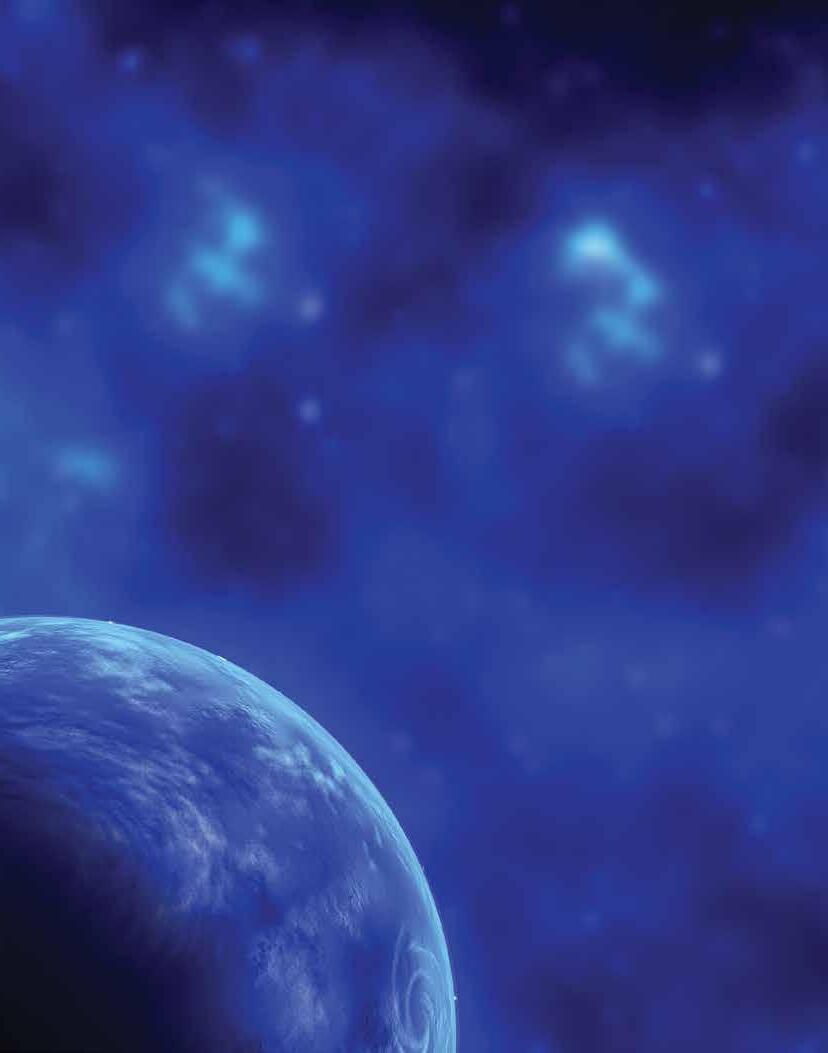




COSMIC ECONOMY NAVIGATING THE WEALTH OF SPACE Amidst the highs and lows of global economy, the foray of innovative new space startups and dynamic enterprises are rewriting the rules of the game. Subscriber’s Copy. Not for Sale YOURGEOSPATIALINDUSTRYMAGAZINE R.N.I NoUPENG/2010/34153; Registration no: UP/GBD-136/2017-19 Publication: 10 th of Bi-monthly I Posting: 15 th / 20 th of every second month www.geospatialworld.netJULY-AUGUST2023»VOLUME13»ISSUE04|ISSN2277—3134 Alexander MacDonald Chief Economist NASA Clint Graumann CEO & Founder NUVIEW DR. BRIAN WEEDEN Director, Program Planning, Secure World Foundation In Conversation Corner Office Interview P06 P08 P30 MIKE BECHTEL Chief Futurist Deloitte Interview P21
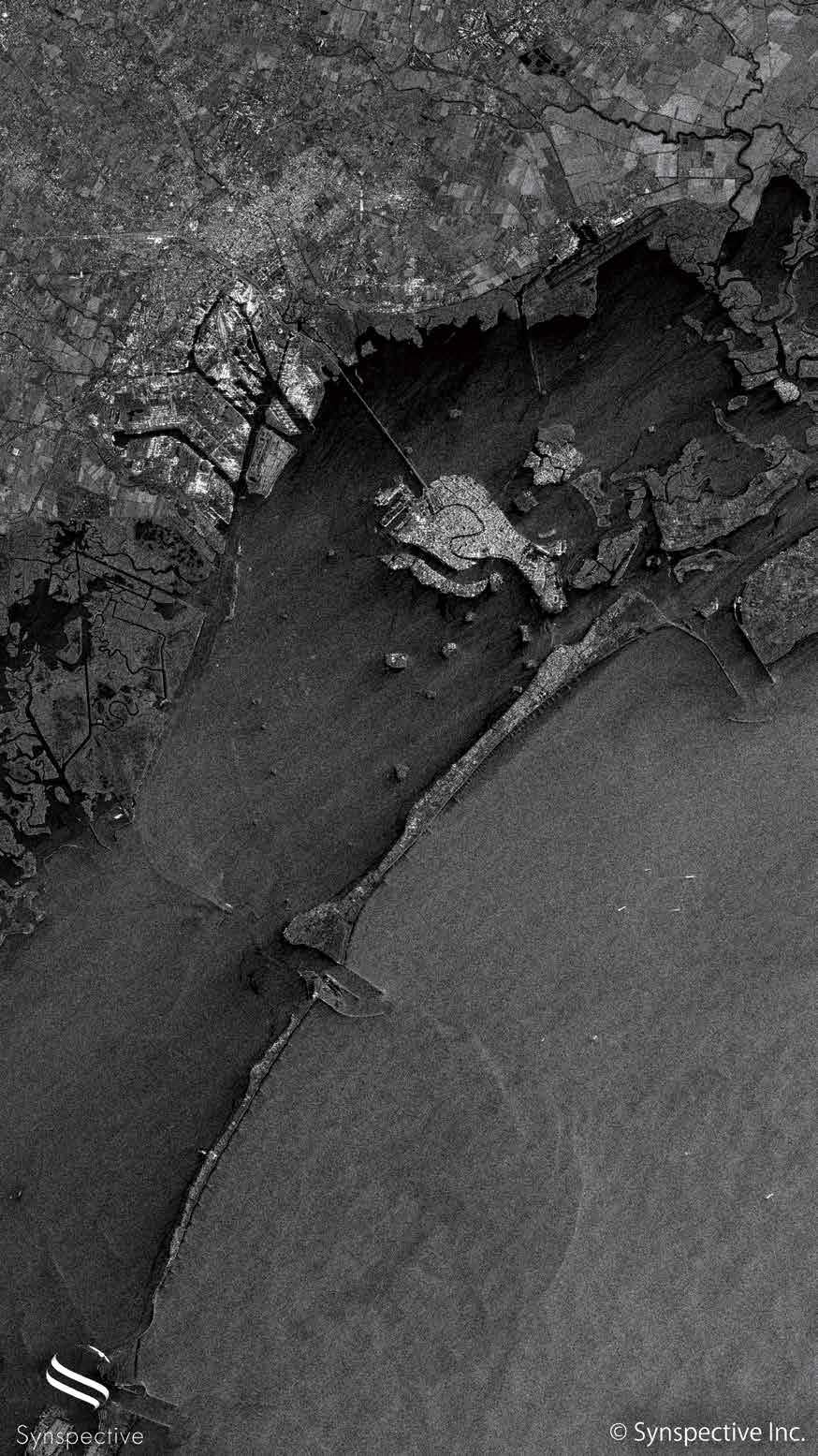









Sanjay Kumar
Managing Editor
Prof. Arup Dasgupta
Contributing Editors
Geospatial Infrastructure



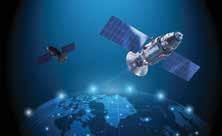
John Kedar
Global Defense and Security
Keith J. Masback




Associate Editors
Geospatial World Aditya Chaturvedi
Europe
Meenal Dhande
Asia Pacific
Sarah Hisham
Assistant Editor
Nibedita Mohanta
Sub Editors
Sachin Awana
Jeffy Jacob
Chief Designer
Subhash Kumar
Visualizers
Pradeep Chauhan
Saurabh Srivastava
Circulation
Harender Rawat
Vijay Singh
Disclaimer
Geospatial
does
necessarily subscribe to the views expressed in the publication. All views expressed in this issue are those of the contributors. Geospatial World is not responsible for any loss to anyone due to the information provided.
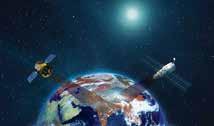
Clint
NUVIEW World’s First LiDAR Map of the Globe Corner Office P08 CONTENTS MARKET TRENDS SPACE RACE LUNAR PROBE BOOK REVIEW 10 / New Space Economy: The Future is Now? 44 / Brave New World of Space 32 / India and China Contrasting Space Programs 16 / Fascinating Facts About Chandrayaan-3 54 / Demystifying High-Res Imagery 40 / Who Owns Space?
Graumann CEO & Founder,
Editor-in-Chief
VOLUME: 13 / ISSUE: 04
Owner, Publisher & Printer: Sanjay Kumar Printed at All Time Offset Printers F-406 Sector 63, Noida - 201 301, Noida (UP) India Publication Address A - 145, Sector - 63, Noida, India Geospatial World: The edition contains 56 pages including cover. Geospatial Media and Communications Pvt. Ltd. A - 145, Sector - 63, Noida, India Tel + 91-120-4612500, Fax +91-120-4612555/666 Price: INR 150/US$15 ON THE COVER The Force Multiplier Geospatial Infra Enabling Space Business The Long Shot Pathways for European Space Business IN CONVERSATION CASE STUDY INTERVIEWS 06 / Telcos, EO Key Growth Areas in Space 14 / SAR Catalyzing Offshore Wind Energy Projects 24/ High-resolution satellite imagery from UP42 offsets emissions 21 / New Space Age Unlocks Exponential Innovation 30 / Need of Protocols, Consensus for Space Security Alexander Macdonald Chief Economist, NASA Mike Bechtel Chief Futurist, Deloitte Dr. Brian Weeden Director, Program Planning, Secure World Foundation P18 P26
World
not
The Rediscovery of Space S
pace related activities in 2023 are achieving new heights through the development of advanced technologies for science, and Earth Observation applications including reconnaissance, tourism, communications, and deep space exploration.
Governments globally remain big spenders in this field. They have built extensive infrastructure for supporting space activities. However, with the advent of risk-taking entrepreneurs, many of these activities are now being monetized. And it’s not an easy game!
Prof. Arup Dasgupta arup@geospatialworld.net
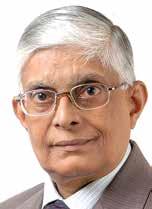
While, SpaceX became famous with their reusable launchers which brought launch costs down, Blue Origin who made a foray into space tourism have filed for bankruptcy. At the same time, others are still soldiering in search of that golden opportunity in launchers satellites and applications.
Small satellites have brought in the concept of constellations which require multiple satellites to be launched by one launcher. This has revolutionized downstream applications such as internet connectivity and multiple revisit remote sensing.
As the world’s first artificial satellite, Sputnik-1, launched by the erstwhile USSR in October 1957 began to circle the Earth, politicians realized that this was just a first step toward the domination of Space by humans. It is to the credit of the United Nations that by 1967, barely a decade after this event, a treaty entitled “Treaty on Principles Governing the Activities of States in the Exploration and Use of Outer Space, including the Moon and Other Celestial Bodies” was deposited by the USSR, UK and USA in January 1967 and came into force in October of the same year.
Clearly, Space was recognized as a major frontier and it was necessary that a common ownership be
established in the name of the Human Race. Now, several decades later the Outer Space Treaty, as it was commonly called, is facing a challenge to its founding principles.
While weapons of mass destruction, mainly nuclear weapons, were banned from being placed in Outer Space, countries got by declaring that a weapon transiting through space did not break this rule. Even an anti-satellite weapon was justified because it was not ‘placed’ in space. Today all major Space faring nations are busy building up their military wing for operations in Space.
Apart from this, the commercialization of space also brings its own problems. The UN Principles of Remote Sensing is silent on the sensing of a country by another country and the sharing of that data to a third country.
This had raised many issues but with commercial access to remote sensing by many countries this became a non-issue. Access to space has been monetized to the extent that any country can commission, own and operate space assets and, as we have seen lately, this extends to assets for other celestial bodies as well.
The Artemis Accord is perhaps one approach to bring some regularity to celestial resource exploitation, particularly the Moon. It should be noted that Russia and China have also planned separate Lunar bases and that the EU is not a signatory to the Artemis Accord.
In this very fluid situation, the future of Space will require humanity to rethink and relook at what was agreed in 1967. Many changes have been made but the rapid expansion of activities may require a new approach. We have a precedent in the Antarctica Agreement.
4 | www.geospatialworld.net | July-August 2023 EDITORIAL
Save the Date
GW EVENTS-CALENDAR 2023-24 16-19
Year after year, the Geospatial World Conferences maintain their reputation as the ‘must attend thought leadership’ events.




Produced By www.geospatialworld.net
October 2023 Hyderabad India
December 2023 Mumbai
January 2024 Monterey California
May 2024 Rotterdam Europe
6
9-11
13-16
Telecom, EO Key Growth Areas in Space
An interaction with NASA Chief Economist on the evolving paradigms of space commerce, key technology drivers, multilateral collaboration, and more.
“The future of the space business is headed for sustained growth, particularly in areas related to telecommunications and earth observation. Satellite capabilities in these areas are vital to countries and organizations around the world”, says Alexander MacDonald, Chief Economist, NASA in an exclusive interview.

between NASA and ISRO, as well as between respective industry partners of the two countries. There are multiple economic areas where we see increasing cooperation and integration – from earth observation, to human spaceflight, and even to future commercial space stations.
India signing the Artemis Accords creates new opportunities for further collaboration and integration. The global space economy is growing strongly, and
both US and India are positioned to benefit from it.
In a 2014 NASA report, 'Emerging Space: Evolving Landscape of 21st Century Spaceflight', you said that USA stands at the opening of a 'Second Space Age’. Close to a decade later, how would you define the contours of this new space age?
The contours of our current space age include more diverse actors, both in terms of countries and
With India joining the Artemis Accords and the ongoing NASA-ISRO partnership in NISAR satellites, space collaboration between Washington and New Delhi has deepened over the years. How do you view it in terms of mutual economic impact across sectors?
We see more and more US-India space collaboration emerging
6 | www.geospatialworld.net | July-August 2023 IN CONVERSATION
private sector actors. All of them aided by a lower cost of space access. As more and more countries have their own space agencies, space is no longer just about large countries and their interests.
With increasing private sector involvement, commercial interests and the intrinsic motivations of individuals are increasingly become drivers of the industry. This creates both new challenges and new opportunities.
There has also been an overall increase in the global ambitions of the space sector, with major long-standing community goals, such as a sustained return to the Moon, and a first human mission to Mars, being enabled by the new investments and new actors of this new space age.
Since the launch of Sputnik 1 in 1957 that kick-started the Space Race, to around 10,000 satellites in orbit today, mostly by private companies, the realm of space has transformed tremendously. Where do you think is the future of space business headed?
The future of the space business is headed for sustained growth, particularly in areas related to telecommunications and earth observation. Satellite capabilities in these areas have proved vital
to countries and organizations around the world.
In addition, we are seeing more and more private activity in exploratory areas, such as commercial human spaceflight and robotic space exploration on and around other celestial bodies.

With the cost of space access being reduced, the cost of experimentation and new ventures is also being cut, so we should expect new market niches and opportunities to emerge.
Earth Observation is crucial for climate change mitigation efforts, be it methane monitoring or change detection. How do you think can the economic aspects of space be merged with the dire need to ensure sustainability? Space provides a unique vantage point for studying, understanding, and monitoring activities and changes on planet Earth. As satel-
lite technology, and the software associated it improves and gets more accessible, the insights from space-based observations can be utilized by more people for governmental, industry, academic, and non-profit uses.
Observations from satellites are one of the only ways to get uniform data-sets for activities and changes across the globe, and so they are an important underpinning of international sustainability initiatives. Open data and open science protocols are critical in this regard.
Reduced cost of space access is already making low-cost earth observation satellites more common. The next step is to see a commensurate focus on supporting capacity development of users of satellite earth observation data to make full use of the potential for space to contribute to sustainability.
Interviewed by Aditya Chaturvedi
The contours of our current space age include more diverse actors, both in terms of countries and private sector actors.
July-August 2023 | www.geospatialworld.net | 7
World’s First LiDAR Map of the Globe
It can be used to map terrain, calculate biomass, or identify potential infrastructure issues. Compared to plane and dronebased LiDAR, a satellite approach offers global coverage and repeated timely scans.
Earth Observation sector is going through a lot of changes due to increased cloud capabilities, refined analytics, rapid cost-reduction, technological convergence and interoperability. Where do you think is the future of the sector headed, and how do you foresee NUVIEW’s role in this evolving ecosystem?
The Earth Observation sector is transitioning towards high-frequency, high-resolution data collection, enabled by technological advancements and cost reductions. This allows for more accurate and timely insights.
Commercial applications of LiDAR to illuminate terrestrial zones, or identify subterranean areas or submerged past worlds is quite well known, but Florida-based NUVIEW is literally taking LiDAR mapping to the skies and beyond, aiming to cover the entire globe.
“What distinguishes us is the commitment to continuous, realtime monitoring, and tracking three-dimensional changes on Earth's surface. Our innovative vision lies in the precision, comprehensiveness, and dynamic nature of our data, ultimately transforming our understanding of
the planet, says Clint Graumann, CEO & Founder, NUVIEW, in an interview with Geospatial World.

NUVIEW plans to map the entire Earth using LiDAR, an innovative breakthrough quite ambitious in scope. Since this is a one-of-its kind project, quite distinct from the conventional use-cases of LiDAR, what do you think is the inherent advantage of this approach?
The inherent advantage of NUVIEW's approach lies in the sheer scale and continuous nature of data collection. LiDAR can accurately create 3D models of landscapes, structures, and vegetation, greatly benefiting many fields such as geography, forestry, geology, and urban planning.
NUVIEW could play a significant role in this ecosystem, providing a unique data source that complements other forms of imaging. Its data could be integrated into analytics platforms to create novel insights, aiding in areas like environmental monitoring, infrastructure planning, and climate change mitigation.
Tell us about the founding philosophy and vision of NUVIEW Space?
At NUVIEW, our mission is to revolutionize Earth Observation by delivering the most accurate, comprehensive 3D dataset of the Earth's surface through our LiDAR satellites. We aim to set the global standard for digital elevation models by concurrently collecting Digital Terrain and Surface Models.

CORNER OFFICE 8 | www.geospatialworld.net | July-August 2023
A conversation with NUVIEW CEO on mapping the globe, future of space, and more.
What distinguishes us is our commitment to continuous, realtime monitoring, enabling us to track three-dimensional changes on Earth's surface.
Our innovative vision lies in the precision, comprehensiveness, and dynamic nature of our data, ultimately transforming our understanding of the planet.
With enormous volumes of high-resolution satellite data at our disposal, what do you think are the gaps that need to be plugged for gaining actionable insights for a better tomorrow? With the massive influx of high-resolution satellite data, the key challenge is extracting meaningful insights from the raw data. Machine learning and AI techniques will be crucial in processing and analyzing this data.
Additionally, there is a need for better data integration platforms to combine different types of satellite data (like optical, SAR, and LiDAR) to provide more comprehensive insights.
Climate Change and its cause-and-effects such as deforestation, thawing ice on polar caps, melting glaciers, aridification, oceanic pollution, etc. are best mapped using change-detection technique. How would NUVIEW contribute to deep knowledge of such changes for advancing climate change mitigation efforts?
NUVIEW's LiDAR satellites would provide valuable data for climate change mitigation efforts. As has been reported in the press, we’ve gained some notable support from
the environmental community.
High-resolution, 3D nature of LiDAR data can be used to detect changes in vegetation, ice caps, and other environmental features. With frequent, repeated scans, this could be a powerful tool for tracking the progress of climate change and the effectiveness of mitigation strategies.
AI and ML are poised to be game-changers in the EO and space industry globally. What’s your take on it, and how much do you rely on these technologies?
AI and ML are indeed on the cusp of revolutionizing the EO and space industry, especially given the vast and complex data that systems like NUVIEW’s LiDAR satellites will generate. The volumes of data from LiDAR—comprising immense numbers of data points, each with discrete values—present a rich resource for these technologies.
The granular detail and three-dimensional nature of LiDAR data make it an ideal candidate for AI and ML applications.
Algorithms can be trained to recognize patterns and anomalies, classify features, and predict changes over time, leveraging the depth and precision of the data. The synergy between LiDAR data and AI/ML is poised to unlock unprecedented insights.
While the massive volume of LiDAR data presents a challenge, AI and ML are uniquely equipped to manage, analyze, and interpret this information. By enabling efficient data processing and sophisticated pattern recognition, these technologies are instrumental in realizing
the full potential of the valuable data that NUVIEW generates.
What do you think are some of the structural limitations and challenges that the space sector faces?
Space domain awareness is an increasingly critical concern. As more satellites are deployed, good stewardship of orbits becomes vital.
Managing and tracking the proliferation of satellites to prevent collisions and maintain sustainable use of space orbits is a major responsibility for all spacefaring entities.
Ensuring the longevity of our shared space environment necessitates mindful operation and thoughtful design of satellite systems, a challenge that will only grow as the industry continues to expand our activities in space.
As we prepare for a transition to Industry 4.0, what do you think would be the role of geospatial and EO in an era defined by 5G, IoT, and industrial automation?
In the transition to Industry 4.0, geospatial and Earth Observation (EO) technologies will crucially influence data-driven decision-making.
They will play significant roles in optimizing supply chain routes, monitoring infrastructure health, predicting environmental risks, enhancing agricultural efficiency, supporting smart city development, and aiding in automated operations.
Interviewed by Aditya Chaturvedi
July-August 2023 | www.geospatialworld.net | 9
New Space Economy The Future is Now?
Due to low-launch costs, frequent revisit, and rapid innovations, private players been at the vanguard of radically transforming the space sector. But what lies ahead? By
Dr. Maureen Haverty, Principal, Seraphim Space
Since the start of the Space Race in 1955, outer space has been dominated by governments. Initially driven by national agencies such NASA, Roscosmos, or ISRO, over time the focus shifted towards major aerospace and defence contractors.
Purely commercial companies were been formed mainly to deliver communications from geostationary orbit (GEO). In the last decade, the industry has shifted again to one driven by private investment and start-ups, which is called the “New Space Economy”.
Seeing the fast-paced change, some questions arise: how did this change happen, where is the industry now, and what is the future?
Key Drivers
The New Space Economy was started by four major developments: launch rideshare; more affordable satellites; satellite constellations; and VCs investing in space.
Since the beginning of the satellite industry, almost every decision made about space, from engineering, to operational, to financing, has been influenced by the highcost and infrequent nature of launches.
With expensive launch services, the cost of failure has conventionally been very high. If a satellite failed it could cost millions of dollars to buy a new launch, scheduled years ahead. This made engineers conservative – if you could not afford to launch again, you had to ensure your satellite could not fail.
The problem here is that it drives up cost, and adds more redundancy than necessary. It also led to engineers often used flight-proven parts – mostly old technology.
Twin Game-Changers:
LEO & Space X
SpaceX’s Falcon 9 changed substantially reduced launch costs down costs to less than $5000/kg. It also sent satellites to orbit almost on a weekly basis this year. Now, engineers can afford to have the occasional satellite fail – if it did, they could launch again soon.

MARKET TRENDS
10 | www.geospatialworld.net | July-August 2023
Satellite engineers are able to take advantage of this steep price reduction by building cheaper satellites, often made from commercial-off-the-shelf automotive parts. These parts were more likely to fail than heritage components but offer unprecedented high-performance.
As a result, satellite manufacturers can build cheaper satellites that are often better than older designs. This lead to the launch of low Earth orbit (LEO) constellations with better coverage and revisit rates than older GEO satellites. Frequently replacing old satellites also became possible due to latest innovations.
With falling costs, frequent improvements, and adoption of newer technology , Venture Capitalists (VCs) saw a market ripe for disruption. This motivated early investments in SpaceX, Rocket Lab, Spire, and Planet, to name just a few.
Market Ripples
The most successful New Space companies today generate revenues ranging from hundreds of millions to billion dollars annually, in the case of Space X.
Many of these companies have gone public via de-SPAC, often an easier method to go public, with less scrutiny of company financials.
However, a difficulty for these companies is that public market investors have punished them for weaker financials, particularly the fact they are not profitable yet. This has pushed most of these “de-SPAC” companies share price down, despite increasing revenues and large contract wins.
SpaceX has decided to stay private for this reason. Recently leaked data suggests that SpaceX hit profitability this quarter, which means it could head towards an IPO.
Share of the Pie
Most of the largest new space startups fall into one or more of three categories: Launch, Earth Observation, Communications, and Satellite Manufacturing.
Launch has been an early frontrunner for private investment and new startups, as a core enabling technology for the industry.
What was once a very stagnant sector, often with national monopolies, now has over 90 startups globally developing their own rockets.
The US has the strongest launch start up ecosystem with: SpaceX, Rocket Lab, Firefly, and Blue Origin. Europe has several contenders
although none have launched yet: Isar Aerospace and RFA.
India is also drawing on its rich launch heritage in ISRO’s PSLV, with Skyroot Aerospace, a new launcher company.
The Earth Observation sector has seen a surge in startups leveraging different technologies to capture geospatial imagery. Optical imagery, the most advanced commercially with several leading New Space providers that have gone public such as Planet, Satellogic,and Blacksky.
Meanwhile, ICEYE and Capella Space are pioneering efforts in Synthetic Aperture Radar (SAR), providing unique insights irrespective of weather conditions.
Both technologies and the startups using them have been used frequently in Ukraine for military
The biggest growth in investment over the past years has been seen throughout the rest of the world (RoW). Outside of the United States, European countries, China, and Japan, the total investment in space in the rest of the World has increased from 24 million Euro in 2019 to 837 million Euro in 2022. This represents an incredible 3379% growth over three years.
The New Space Economy was started by four major developments: launch rideshare; more affordable satellites; satellite constellations; and VCs investing in space.
Source: European Space Policy Institute Report 85Space Venture Europe 2022 July-August 2023 | www.geospatialworld.net | 11
intelligence and open source intelligence (OSINT). Some technologies are only just starting to be deployed by startups, such as hyperspectral imaging by India’s Pixxel, and infrared imaging by SatelliteVu.
These latter technologies are particularly useful for climate change-related monitoring: hyperspectral can be used to detect methane leaks, while infrared can monitor heat signatures in buildings.
One of the oldest satellite sectors, communications is increasingly driven by LEO constellations to deliver reduced data latency. SpaceX's Starlink and the Bharti Airtel backed OneWeb aims to deliver global internet coverage for both consumers and enterprise.
Direct-to-cell technology, is an emerging area, enabled by changes to the cell phone network interoperability standards 3GPP which allow satellites to act like cell towers in space.
These changes are poised to revolutionize both IoT devices and conventional mobile communications. Companies like AST and Lynk are at the forefront of broadband technology, whereas Skylo is making waves in the narrowband segment.
In the Hindsight
All of these developments have been better than what could have been anticipated 10 years back. But in EO, there has been less commercial adoption of geospatial data
than anticipated by companies and investors. All of the new EO companies derive more of their revenue from government than expected.
There are several possible explanations for this. The government is the biggest user of EO data and may always be. EO data may still be too expensive for commercial applications. Or it’s possible that industry still does not know how to use EO data effectively.
There are some arguments that because of limited adoption of geospatial data thus far, commercial industry has found workarounds to using geospatial data, or certainly space-derived data.
From Info to Solutions
The focus now, for next-gen startups and innovative companies, is shifting from merely collecting and delivering space data to building comprehensive products around it.
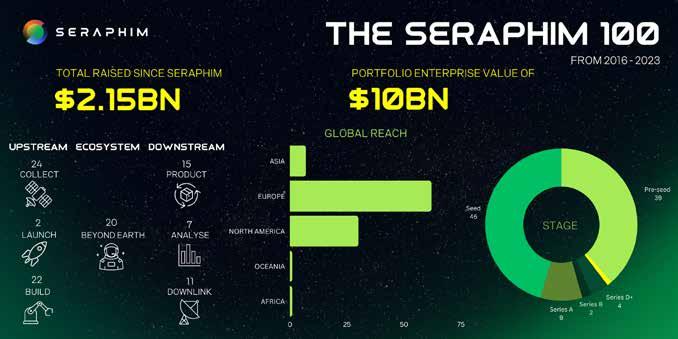
Their aim is to deliver crucial insights or information to the end customer, often bundled with other

growth throughout this period
With falling costs, frequent improvements, and adoption of newer technology , Venture Capitalists (VCs) saw a market ripe for disruption. This motivated early investments in SpaceX, Rocket Lab, Spire, and Planet, to name just a few.
12 | www.geospatialworld.net | July-August 2023
The 100 companies supported by Seraphim have collectively raised $2.2bn in equity funding with an enterprise value of more than $10bn
MARKET TRENDS
data sources. These end-users might not even be aware that space data is involved.
This makes space-derived data accessible and useful to non-specialists, particularly in sectors like finance and insurance. Many of the founders don’t come from space but instead from the sectors they are selling into, solving real problems within the industry.
The biggest drive for space data products is coming from climate-related startups. As space gives you both a global and local view at the same time, it is ideally suited for climate applications.
In addition, the ability to independently verify with space data, makes it perfect for monitoring applications. There are a wide variety of potential applications.
Startups are starting to build wildfire and natural disaster insurance products using improved risk models that leverage space data. Space derived data is being used by several startups for carbon credit
verification, proving whether deforestation has been prevented or how much carbon has been sequestered in a project.
Limitations of Space Data?
Many have argued that space data has been adopted less than expected because it’s only adding some additional information to existing data streams, often provided at low-cost by the government.
Coupled with this fact, it often has to be handled differently. It’s easy to see how this could be limiting its use in data science models. But in regions where we don’t have many existing data streams, space geospatial data can provide a lot of information in a single data stream, removing the need to implement different tools or measures.
In these cases, space can be very useful for insurers or hedge funds who can easily access validated information in developed markets but have much more limited information in developing markets. For example,
space data can provide information on productivity or examine whether a factory is working at full capacity.
Reaping Mass Benefits
Space as a sector has been fundamentally disrupted by technology evolution and the first wave of startups. By developing the core infrastructure of the New Space Economy, these companies have reshaped how we launch, build, and use satellites, generating real returns for investors in the process.
With increasing fundings, the next wave of startups will focus on bringing space data to the masses. Their space data products could make the use of geospatial data ubiquitous.
Dr. Maureen Haverty
Maureen is a deep-tech VC based in London with a successful career in the new space industry. She is an Investment Principal at Seraphim Space, a space specialist venture capital firm investing globally with ~$250m AUM. She is also a board observer for D-Orbit, Atmos, and Edgybees. She was an early-stage employee and COO at Apollo Fusion, a space startup, that sold for $145M, one of the largest ever acquisitions of a space component company.

Source: European Space Policy Institute Report 85Space Venture Europe 2022 July-August 2023 | www.geospatialworld.net | 13
Global Investments & Deals
SAR Catalyzing Offshore Wind Energy Projects

Climate change, carbon emissions, and fossil fuel depletion have been significant global concerns for decades. The push for a greener future has led to the development of blueprints and initiatives aimed at elevating society as a whole and mitigating the risks of climate destruction.
The global energy sector is among those experiencing a transformative shift Revolutionary technologies such as solar power and batteries are paving the way for a more sustainable future. Additionally, offshore wind energy farms are gaining traction and expanding into new deployment areas. Notably, offshore wind capacity is projected to reach 630 gigawatts (GW) by 2050, according to McKinsey.
Analysts predict that offshore wind energy projects could generate up to 80,000 jobs annually by 2035. The Asia-Pacific region is anticipated to lead the global offshore wind energy installation, targeting a capacity of 450 GW by 2050.
Nonetheless, the deployment of offshore wind farms remains a complex and challenging endeavor, involving substantial financial risks. Traditional mapping and wind assessment technologies come with limitations.
However, Synspective, a Japan-based satellite data and solutions provider, has leveraged Synthetic Aperture Radar (SAR) technology through satellite-based optimization to streamline the entire process.
SAR Features and Benefits
SAR technology enhances confidence by offering actual observation data of sea surfaces compared to the current simulation based methods. This provides customers with tangible insights into changing wind patterns and their responsiveness to fluctuations in large areas and in high resolution.

14 | www.geospatialworld.net | July-August 2023 CASE STUDY
Offshore Wind Direction in the Sea of Japan coastal area near Akita Pref. ©Mapbox / ©OpenStreetMap Improve this map / ©Copernicus Sentinel data [2014-2021] ©Synspective Inc.
Challenges
• �Due to the relative novelty of the offshore wind energy industry, challenges arise from a lack of established rules and standard practices, as companies are still in the learning phase.
• �Accurate estimation of wind flows is crucial but requires extensive research and mapping, necessitating long-term investments.
• �Given the large scale of offshore projects, costs can escalate into the billions of US dollars, magnifying the impact of errors. A 10% estimation error could result in multimillion-dollar losses.
• �Even though there has been an increase in available SAR data for wind providers, understanding this data is still very difficult and requires specific expertise. The offshore wind solution allows users to use SAR data for wind power projects without the specific knowledge to analyze these radar reflection records.
SAR satellites provide the ability to image the Earth’s surface day and night, regardless of weather conditions. Advances in technology and an increase of satellite constellations enable us to observe the Earth more consistently. The resulting daily revisit and broad-ranging data observations are already enabling actual offshore wind patterns.
Daily Revisits: The current approach in the offshore industry involves sensors on sea surfaces to measure wind speed, typically at 10-minute intervals. In contrast, SAR data collection used to occur only once every two weeks, requiring more analysis time and more acquisitions of data in order to be more statistically viable. Today, Synspective's satellite innovations have enabled daily wind speed data collection. Furthermore, even higher temporal resolution data is being made accessible, improving accuracy.
Broad-Ranging: Offshore monitoring sensors have limited area coverage compared to satellite observations. Sea areas allocated for wind power plant development
could be as vast as 850 square kilometers. Synspective utilizes SAR data to analyze and guide customers regarding optimal deployment areas for wind farms, addressing placement and development considerations.
Accurate Wind Pattern: Synspective's solution capitalizes on changes in the sea surface caused by wind speed variations. For example, choppier waters indicate higher wind speeds, while calm waters appear dark and reflective.
Furthermore, the impact of constructing large wind farms on regional wind behavior, affecting other nearby wind farms in the planned area, can be visualized using SAR, a factor often overlooked in simulations.

SAR's Offshore Future
Currently, one of the key solutions Synspective is focusing on is the planning phase for the offshore energy sector. The company has been instrumental in mapping and analyzing optimal spaces to initiate wind energy projects and assess wind speed projections.
Analyzed wind speed in the area near existing wind farms. (The Latitude and Longitude degrees show the location of the image area)
©Mapbox / ©OpenStreetMap Improve this map / ©Copernicus Sentinel data [2014-2021]
©Synspective Inc.
The increased temporal resolution enables more rapid and higher-quality wind speed monitoring, offering flexibility in yearly projections. Continued research, data gathering, and industry collaboration will bolster confidence in project implementation.
Synspective's involvement extends to collaborating with developers and consultants on wind farm development. Additionally, the company aims to delve deeper into aspects like construction planning and asset evaluation for wind farms, including potential investments.
In scenarios where wind farms are sold as assets, Synspective's assessments will provide valuable insights into financial aspects, power generation assessments, and enhance the overall understanding of wind farm health and performance.
Synspective’s constant monitoring also provides a more in depth approach to wind energy farming, leading to a more sustainable society.
July-August 2023 | www.geospatialworld.net | 15
Fascinating Facts About Chandrayaan-3
With the successful launch of the Chandrayaan-3, India becomes the fourth country to land on the moon, opening a new glorious chapter in the country’s spacing saga. Let’s look at some fascinating facts about the mission.
First South Pole Landing
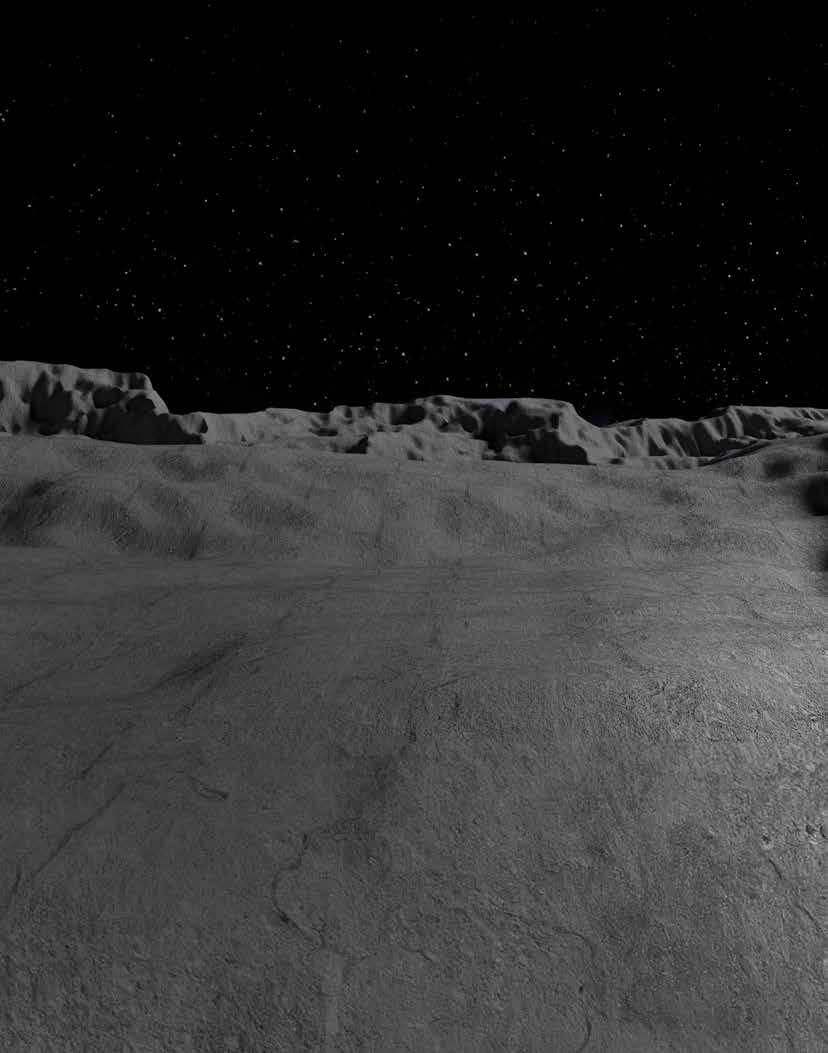
India is the first country to soft-land near the south pole region of the moon. All other previous landings have been near the moon’s equator
Budget Less Than Hollywood Space Movies
The budget of Chandrayaan-3 was $75 million, about half the cost of the Hollywood movie Interstellar. as well as Gravity ($100mn), and The Martian ($108mn) were also more expensive than the Chandrayaan. More Affordable than Pricey Real Estate Chandrayaan-3 cost less than the UKs most expensive home located in London’ prestigious Regent Park worth whopping $419 million.
Beating SpaceX
A single Falcon 9 rocket launch from Elon Musk’s SpaceX costs about $67 million, similar to the entire Chandrayaan-3 project.
Learning from Mistakes
India managed to land on the moon after two failed attempts, whereas the USSR failed 5 times with its Lunar-1. The US, on the other hand, failed 15 times.
One Lunar Night
The life of Vikram and Pragyan rover on the mission is for one lunar night, or 14 earth days, as they are equipped with solar panels.
Slingshot Launch
Instead of using very powerful rockets, ISRO used a slingshot launch where the probe orbited Earth several times to gain speed. This resulted in Chandrayaan-3 taking more time to hit orbit than Apollo 11 did in 1969.

The spot on the lunar surface where the Chandrayaan-2 left its footprints will be known as 'Tiranga'. This will be an inspiration for every effort made by India. it will remind us any failure is not final. This is no ordinary achievement; it’s a roaring announcement of India’s scientific achievement in the infinite universe.
Shri Narendra Modi
Congratulations to India for landing
Chandrayaan-3 on the Moon — joining Russia, USA, & China as the only countries to have achieved this feat. More importantly, it’s the first mission of any country to arrive near the Lunar South Pole - a possible location for future Moon bases.
Neil deGrasse Tyson
India is on the moon.
Honorable Prime Minister of India American astrophysicist Chairman, ISRO


 Sreedhara Panicker Somanath
Sreedhara Panicker Somanath
16 | www.geospatialworld.net | July-August 2023
PROBE
LUNAR
Payload Lander
Separated in 16 minute and nine seconds after launch
LVM3 - M4 Rover Propulsion Module
43.5 meter tall rocket launched from the Satish Dhawan Space Centre on 14 July. Carried payload to an altitude of 111 miles (179) above Earth
Carries the rover and various scientific instruments
Operates for one lunar day (14 Earth days)
Carried the lander and rover to lunar orbit. Will conduct experiments for three to six months

July-August 2023 | www.geospatialworld.net | 17
Geospatial Infra Enabling Space Business The Force Multiplier
The multi-functional salience of geospatial infra in boosting the utility of space applications, would only increase with time.
As per market estimates, the global geospatial industry will cross the trillion dollar mark by 2030. There are various factors propelling robust growth in this sector, including increased demand for high-resolution satellite imagery, precise analytics, actionable insights, HD mapping, and data visualizations.
The ubiquity of geospatial applications and monitoring has increased by leaps and bounds over the years, owing also to the transformative nature inherent to geospatial sector.
From a niche domain, it today encompasses generalists as well as specialists. Be it the location
By Aditya Chaturvedi
economy or the new business models that are tailored to provide solutions and not just data, the sector has evolved with times, incorporating cutting-edge technological advances from AI/ ML to IoT.
For decision-makers and problem-solvers, at all levels, there’s no alternative really to spatial data.
Geo Cutting Edge
“GIS brings together all the data needed for rational, equitable decisions. Data such as infrastructure location and condition can be combined with dynamic usage information”, says Jack Dangermond, Founder & President, Esri.

He believes that geospatial sector is at the cusp of a revolution, powered by the end-users and spurt in the ingestion of spatial data for ‘enterprise-class data intelligence platforms and workflow simplification tools’.

“Interconnected workflows, accessible data sources, and analytics built to leverage continuously changing data about our planet are empowering governments and companies to make more informed decisions than ever before”, says Mack Koepke, Vice President, Global Sales, Capella Space.
Most of the satellites placed in the Low-Earth orbit are for
Investment volume per region Source: European Space Policy Institute Report 85Space Venture Europe 2022 18 | www.geospatialworld.net | July-August 2023 ON THE COVER
imagery analytics, used for a wide range of purposes from change detection to patterns, to enabling telecommunications in far-flung regions.
The scope is truly manifold, from precision agriculture, to tracking pollution, observing maritime pollution, to curtailing global warming. Space is the most reliable source of info for what is happening on the earth, and where.
Koepke believes that from tracking shipping logistics to forecasting demand for manufacturing, to mitigating the impacts of a changing climate, the dependence on space-borne datasets is growing on a daily basis, far outstripping the capability of legacy space constellations.
This demand-supply skew has to be fixed to reap the maximum benefits as well as spearhead innovation. Fresh realization has dawned about the fusion of various sensor types and newer combinations in place to obtain the most precise details.
“The fusion of these datasets with traditional systems like Electro Optical enable unique use cases not previously seen. Commercial and government stakeholders are starting to understand the power of leveraging these datasets for a more consistent view of what is happening on the ground”.
New Applications
As per Alexander McDonald, NASA Chief Economist, telecommunications and Earth Observation are two sectors which are witnessing highest growth in space economy.

Though, alongside space economy and the crucial role of geospatial in it, what tends to get overlooked often, because is the role of geospatial infrastructure in enabling space commerce.
Loosely defined as the end-to-end system of spatial networks involving advanced sensors, upstream & downstream applications, data transmission links, ground stations, servers, and the end products, the role of geospatial infra is crucial.
“In terms of upstream, I think we are seeing a much wider variety of sensors in orbit: optical, SAR, hyperspectral, infrared, and radiofrequency. This increases the type of data that can be delivered to customers”, says Dr. Maureen Haverty, Principal, Seraphim Space.
Easy-to-access proliferation of data such as synthetic aperture radar (SAR) and radio frequency (RF) signals are indeed gamechangers in many ways.
Key Trends
With trends such as ‘Cloudification of geo’, miniaturization of sensors, lowering launch prices, and increased data analytics capability, there is a great demand for spacebased services and solutions.
The market shift from discernible information to customized solutions and products, has not only widened the applications but made them more versatile. It won’t be a cliché to say that the utility of geospatial and space is limited only by our imagination.
“Some of the most exciting developments are happening downstream. Companies building products around geospatial data could substantially increase its utility”, believes Dr. Haverty.

Unarguably, with new iterations of AI such as GeoAi, language training models, Generative AI, and the scramble to build unified platforms, single window marketplaces for geospatial analytics, imagery, geospatial and NewSpace are more inextricable than ever before.
More Constellations
For secure communications, uninterrupted data transfer, nearreal time access to imageries, and detecting methane leaks, there’s a need to frequently increase the number of satellites in orbit, and operate more constellations with a non-stop, day-and-night monitoring capabilities.
July-August 2023 | www.geospatialworld.net | 19
With new iterations of AI such as GeoAi, language training models, Generative AI, and the scramble to build unified platforms, single window marketplaces for geospatial analytics, imagery, geospatial and NewSpace are more inextricable than ever before.
“Once a week is no longer acceptable in global commerce and government decision-making. Customers are interested in continuous and reliable monitoring - day and night - multiple times a day. This can only be accomplished by proliferated new space constellations”, adds Koepke.
At the same time, we also need to upgrade the existing downlinking and transmission capabilities, and build more ground stations.
The gap between data generated and data-in-demand needs to be plugged fast to make optimum use of space-based information and deploy it solve some of our most pressing problems. This is an issue from the vantage point of the end-user as well as the analyst. Another conundrum is the gap between data deluge vis-à-vis solution-oriented analytics and refinement capability.
“The use of geospatial data is currently limited by poor data transmission. The data downlink bottleneck delays time to deliver
insights to customers, reducing its usefulness. The data transmission bottleneck needs to be improved with either in-space data relays or edge computing in space”, adds Dr. Haverty.

There’s also a need to make data unified, standardized, interoperable and easy-to-use. This requires broad stakeholder engagement and agreeing upon key parameters.
“Unless people have a unified approach for sharing and integrating data, it’s very difficult to make that data actionable” asserts Adam Bennett, Vice President – Marketing, HawkEye 360.
Looking back the early days of his company, he narrates that even though they introduced a new type of space-based RF geospatial data, yet they never lost focus on the need to embrace common standards and methods to provide user data.

“The more easily an analyst can input RF geolocations into their common analysis and mapping
tools, the more it will benefit their workflows. That continues to be an ongoing process, where we are now building APIs to further improve interfacing with our data”, he adds.
New Directions
Aditya Chaturvedi ON THE COVER
The New Space economy is witnessing a heady momentum, fuelled by a lot of technological breakthroughs, market liberalization, ease-of-access, and governments and companies’ alike prioritizing space. Innovative space behemoths as well as fledgling start-ups are playing a vital role in this vibrant ecosystem, which is not only exploring mankind’s last frontier, but rapidly breaking barriers.
Koepke believes that launch service providers such as SpaceX and Rocket Lab have been transformative in enabling new space companies to get to space quickly and reliably to the desired orbits.
“This fuels the virtuous cycle of the proliferation of new space constellations”, as per him.
Boosted by increasing market cap, diminishing launch costs, scalability, innovative applications, and other factors such as incentivization and competitive collaboration, the ongoing momentum will continue, along with all pervasive geo integration.
“We continue to see startups exploring methods for geospatial data gathering, given the cost for satellite development and launch is historically low”, adds Bennet.
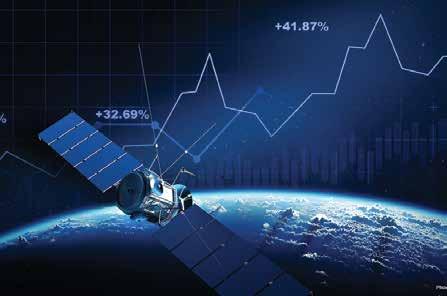
Associate Editor, GW Media Aditya@geospatialworld.net 20 | www.geospatialworld.net | July-August 2023
New Space Age Unlocks Exponential Innovation
A conversation with Mike Bechtel, Chief Futurist, Deloitte on the new era of space exploration, and how it is redefining innovation across myriad sectors, moulding people’s lives, and unveiling new business opportunities.

“The path to space is increasingly affordable, with innovations like reusable rockets and advances in manufacturing dramatically lowering the cost to launch. These changes not only make it more financially sustainable, but they also begin to democratize space access”, says Mike Bechtel, Chief Futurist, Deloitte in an exclusive interview with Geospatial World
What do you think are the key defining trends in space economy today, and what is the impact of exponential technologies such as AI and IoT, or Next (novel and exponential technologies) as you term them?
One of the most significant trends we are seeing is growing commer-
cial engagement in space alongside more traditional government participation. There is no denying the need for national actors to remain at the core of the space economy, but commercial players are contributing at a high level across the full spectrum of the new space economy.
We are seeing this across industries, from commercial space stations that will foster research and development (R&D), to private efforts to develop innovative orbital debris capture systems.
When it comes to exponential technologies, the leaps forward in technologies like AI, advanced robotics, and 3D printing are enabling increasingly autonomous operations in space. Where human involvement was once an expensive and risky requirement, new technology is stepping in to lower costs and increase safety.
Rather than send an astronaut to conduct a risky spacewalk to fix an exterior module, a multifunc-
tional robot can do the job. And why should we have to return to Earth for parts if advanced 3D printing can give us the items we need without having to make an expensive trip?
Ultimately, novel and exponential (NExT) technologies allow us to return to first principles, pushing us toward a more abundant and accessible future. This convergence of factors will ultimately be what propels the space economy forward.
Geospatial infrastructure acts as a key enabler, interface, and catalyst to space applications and systems. How has the role of geospatial progressed over the years, in the run up to New Space, and how would it look like in the future?
Geospatial infrastructure has long existed, from traditional satellites providing services like GPS to data transmissions between spacecraft and mission control on Earth. However, recent innovation in both hardware and software is changing the scope of what’s possible. These advances are set to increase the impact that geospatial infrastructure will have for on-Earth operations.
For example, lower hardware costs and feature miniaturization
July-August 2023 | www.geospatialworld.net | 21 INTERVIEW
have resulted in the proliferation of smaller satellites that can be outfitted with Earth observation (EO) technology. These microsatellites generate robust data streams and provide continuous mapping of the Earth.
This has implications for Earthbased operations like agriculture, climate tracking, and disaster analysis. Growth in the number of satellites outfitted with optical laser communication systems, as well as the ability to use communication relays across satellites in different orbits, is contributing to a more comprehensive data transmission ecosystem.
A wider number of options begets a wider range of use cases that more companies, space-related or otherwise, can tap into and take advantage of as well.
In the latest Deloitte Space Tech report you say that Space today is at an inflexion point akin to 'AgeofExploration' in the 16th and 17th Centuries?
What are the historic parallels you see and why?
When explorers in the Age of Exploration looked to the stars, they saw in them a path to new sources of wealth and opportunity. Centuries later, a new age of explorers is racing towards the stars in pursuit of those same goals and establishing new constellations (of satellites) while they’re at it.
Driven by a desire to deepen our understanding of our world and
universe, empowered by advances in technology, and based in government and commercial partnerships, the ages of sea and space have shaped – and will continue to shape – humanity's future.
While key commonalities may be noble in nature, it is also critical that in this new Age of Exploration, we seek to avoid the pitfalls of our past. We must ensure that the exploration of space does not result in the damaging biological and environmental changes brought about by the previous Age of Exploration. As we relentlessly pursue the future, we must be careful to consider the lessons of our past.
From rocket design and launchers, to the quest for next-gen space stations and multi-functional spaceports that can act as scientific incubators, no facet of space is untouched from ingenious innovation spurred by private enterprise. This is a radical departure from space being a turf of national space agencies. How would it contribute to inclusive economic and social value in the age of increasing protectionist tendencies? The growth of private enterprise in space is opening the door to a new era of abundance. While governments built the launchpads for the current space age, it is blasting off due to commercial involvement. When it comes to protectionist tendencies, it’s important to keep in mind that space is, by nature, a
global endeavour.
When you put a satellite or a space station into low Earth orbit (LEO), you don’t get to decide that it’s only going to orbit over North America, or Africa, or Asia. With the orbital space around Earth getting increasingly crowded, cooperation between the many public and private actors active in orbit will be necessary to prevent collisions and ensure sustainable development.
When it comes to driving inclusive value, a great example of space’s potential is the expansion of mega-constellations – networks of thousands of satellites in low Earth orbit – that are extending internet coverage around the world. This is helping communities in the most remote places on Earth access the internet and benefit from digital services that range from weather forecasts to global communication.
Going forward, it will be important to proactively consider how space-based innovation can drive social impact rather than allow most of the benefits to accrue to a privileged few.
From DARPA’s project that eventually birthed Internet, to NASA’s Apollo Space Program, a lot of state-led projects spawned innovative breakthroughs in multiple sectors. Would we witness the same technology trickle-down in the era of New Space?
We are already witnessing how innovation in space makes a real impact
22 | www.geospatialworld.net | July-August 2023 INTERVIEW
Going forward, it will be important to proactively consider how space-based innovation can drive social impact rather than allow most of the benefits to accrue to a privileged few.
on our world. For example, a spacebased study tracking the effects of microgravity on eye movement gave rise to an eye tracking device that is now used in corrective laser eye surgeries around the world.
Today, researchers are attempting to create new drugs that prevent the atrophying effects of microgravity on the heart – drugs that could someday help patients who struggle with cardiac atrophy on Earth.
The unique conditions in orbit also offer new possibilities for research. The microgravity in space makes it much easier to create three-dimensional cell environments that mimic physiological forms within the human body.
One benefit of this environment is that it allows researchers to better study potential cancer therapies that specifically target tumors, as opposed to also attacking healthy proliferating tissue.
Potential for innovation doesn’t stop at human health and disease. The production of semiconductors with fewer impurities, higher quality fibre optic cables, and the unique ability to use and test products that would normally require harsh environments on Earth are all advantages gained from space-based R&D.
The growth in manufacturing and production capabilities in space will have ramifications on a multitude of industries in ways that we can’t be completely sure of yet.
Space is often touted to be the 'final frontier', yet the increasing 'winner takes all’ high-stakes competition for orbital space would mean some trade-off with the pursuit of sustainability imperative. How to harmonize commercial space with the need for collective common good? The path to space is increasingly affordable, with innovations like reusable rockets and advances in manufacturing dramatically lowering the cost to launch. These changes not only make it more financially sustainable to enter space, but they also begin to democratize space by allowing more companies and countries to have access than ever before.
The democratization of space, and sustainability in space, are vital considerations for leaders at the forefront of the new space economy. Companies at the vanguard of the space industry are building infrastructure that will make the connection between Earth and space commonplace.
On the sustainability front, there is also an opportunity to resurrect new industries charged with cleaning up space debris. At present, there are more than 25,000 pieces of debris larger than 10 centimeters in orbit that are a threat to collide with larger satellites and space stations. Companies are tackling this problem by learning how to prevent future debris and experimenting with removing debris in orbit.
What is the Deloitte vision for Space?
Deloitte views space as table stakes for enterprises that want to thrive well into the future. Space transcends economic, national, and scientific boundaries, holding the potential to disrupt industries as we know them. Beyond its transformative impact on business and government, space inspires. It serves as a potent reminder of our common humanity and cultural symbol unlike any other.
Today, as we witness the advent of a new space age, we feel that the possibilities on the horizon – or, more accurately, above the horizon – are truly revolutionary. We want to help our clients engineer a future advantage by helping them see the possibilities that space holds, today.
Winning in this exciting environment demands innovation, agility, and precision. Organizations preparing to compete in space must be ready to face a changing regulatory environment, complex technological obstacles, and rapid innovation in market –among other challenges.
Dynamic human capital, ranging from engineers to strategists to creators, is vital for navigating a world where every company is, in some way or another, a space company. Those that succeed will unlock trillions of dollars in value, while shaping a new legacy for humanity and for their organization.
July-August 2023 | www.geospatialworld.net | 23
Dynamic human capital, ranging from engineers to strategists to creators, is vital for navigating a world where every company is, in some way or another, a space company.
Interviewed by Aditya Chaturvedi
High-resolution Satellite Imagery from UP42 Offsets Emissions
Founded in July 2021, CarbonStack accelerates the transformation to carbon neutrality by offsetting emissions with local compensation projects. Their mission is to help Europe become the first carbon-neutral continent by supporting afforestation projects. The transparency of their operations is especially important to CarbonStack: that’s why they use blockchain technology to document their activities, creating a publicly accessible ledger that shows the impact of each afforestation project as well as the link between forest initiatives and the companies that invest in them.

Challenge
Many industries struggle with the transformation to a state of net-zero emissions. Companies aim to reduce and avoid emissions quickly but are held back by technological barriers and unavoidable residual emissions. As a solution provider, CarbonStack works with organizations that want to offset their current greenhouse gas emissions, to reach net-zero faster and more sustainably. They do this through the afforestation of damaged European forests to offset currently unavoidable emissions.
CarbonStack wants to accomplish two things. First, there’s the critical task of enabling companies to become carbon-neutral. Carbon offsets play a crucial role in reaching the global 1.5°C target. However, a substantial trust issue exists considering the actual impact of compensation projects. Thus, the ecological implications of the companies involved in these compensation projects are often debated. CarbonStack aims to resolve this issue by creating more transparency for its projects with earth observation and blockchain technology.
Secondly, CarbonStack enables its clients to invest in local projects as close to the corresponding emission as possible. By doing so, they help their clients to improve their standing in local markets. The company is currently focused on afforestation projects. Forests make it easier to monitor and visualize the impact of carbon offsets. This task necessitated a deep understanding of many factors, from finding suitable areas for afforestation to
24 | www.geospatialworld.net | July-August 2023 CASE STUDY
detecting and monitoring the carbon uptake of tree species. Previously, they used imagery from drones and airplanes, but this was costly and often wouldn’t provide images of a wide enough area or a detailed enough resolution.
Solution
To address these challenges, CarbonStack works with UP42 to gather high-resolution satellite imagery. Upon ordering high-resolution images for predefined forest areas, CarbonStack can monitor their order status and download the assets when ready with UP42’s storage, which centralizes all of their datasets and is accessible via a web browser or API. The Pléiades Neo constellation, which captured these images, boasts a 30cm native resolution. This lets CarbonStack identify individual trees, a feat that wouldn’t be possible with lower resolutions. CarbonStack then applies a machine learning algorithm that categorizes trees by species and growth stage to measure their carbon offsetting capabilities.
Outcome
UP42 and Pléiades Neo give us the opportunity to use satellite images instead of drones or airplanes for our forest monitoring. This approach is much more flexible and cost-efficient than previous methods.

With Pléiades Neo imagery from the UP42 platform, CarbonStack could analyze areas of interest in Germany, Austria, and Switzerland to identify and monitor over 1.5 million trees. This monitoring includes nearly 50,000 trees CarbonStack planted this spring alone throughout the Harz Mountains and the German state of North Rhine-Westphalia for their clients. Projects like this show local populations that CarbonStack’s customers are taking real action to offset their carbon emissions. And the data is then added to Carbonstack’s ledger, which is publicly available on their blockchain for anyone who wishes to access it. This infrastructure delivers long-needed transparency to the carbon offsetting market. CarbonStack is working with the Algorand Foundation to create a new generation of registries for nature-based climate solutions.
Julian Kakarott CEO of CarbonStack

Pléiades Neo’s acquisition capacity of 2 million kilometers squared per day and the flexible minimum area of interest requirements allow CarbonStack to order images of the exact scenes they desire. Plus, thanks to UP42’s credit consumption-based pricing, they only pay for what they need.
By using satellite imagery instead of drones or aerial data, CarbonStack was able to save on time and costs. Looking ahead, they’re planning to expand their areas of operation beyond Europe, starting with North America, where there are many more carbon-offsetting opportunities. And they’ll continue to rely on trusted cooperation with UP42.
July-August 2023 | www.geospatialworld.net | 25
The Long Shot Pathways for European Space Business
European space sector is witnessing consistent growth, tech innovations and influx of new investments, however there are challenges that needs to be tackled.
Space has always been a source of inspiration to humankind. In the pursuit of exploring space numerous revolutionary technologies and in-depth scientific knowledge has been developed.
Not long ago, space as sector was far away from the private players because of the huge costs and risks involved. It used to be synonymous with government spending.
By Meenal Dhande
However, significant technology advancements and a new entrepreneurial spirit are rapidly shaping a new space economy. The industry sees the emergence of new private actors who see unrivalled commercial opportunities in space exploration.
Today, space has improved daily life in many ways; according to the European Space Agency (ESA), for every Euro spent in the
sector, there has been six Euros benefit to society.
Space Business
Morgan Stanley estimates that the global space industry could generate more than $1 trillion or more in 2040, up from $350 billion. At the same time, GW Consulting estimates $ 202.5 Billion Worth of Investments (including IPO and SPAC) in the Geospatial (including Space) Industry.
In the global space economy, satellite services represent the most significant sector (around 37 %), closely followed by ground equipment. Earth observation (EO) is the biggest satellite manufacturing and launch service user and remains a crucial driver for the overall industry. Space hardware and space applications have been important users of innovations in sectors outside of the space industry.
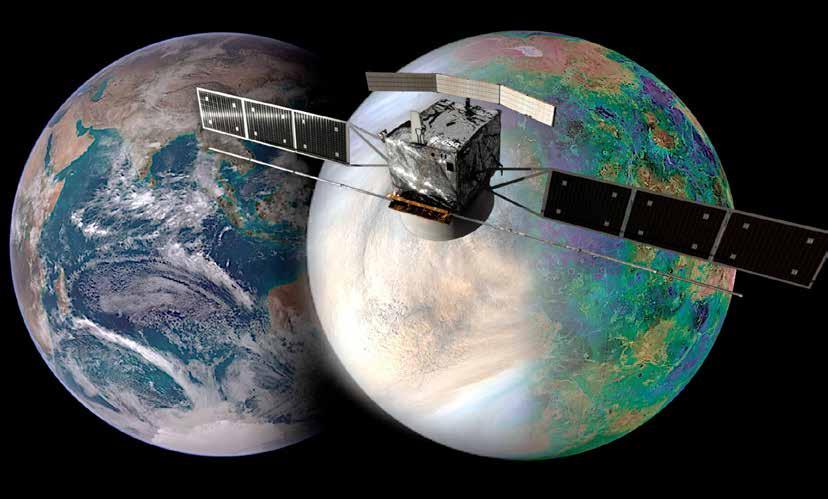
ON THE COVER 26 | www.geospatialworld.net | July-August 2023
Advances in manufacturing technologies, miniaturization, AI, and reusable launch systems have driven market disruption in the space industry. Scientific and technological progress go hand in hand and can lead to disruptive innovation, resulting in a new market with a radically different value proposition.
“Rapid technology progress fuelled by spin-in of terrestrial digital technologies and the decrease in launch cost allow for completely new missions to be realized and developed in a much shorter time than before”, says André Wall, CEO, Beyond Gravity.
European Funding Landscape
Along with the rest of the world, space sector has gained significant momentum in the European Union (EU) due to the need to use space for effective defense and climate change. Established in January 2021, the Directorate-General for Defence Industry and Space (DEFIS) leads the European Commission’s activities in the defense industry and space sector.
In the area of space, DG DEFIS is in charge of implementing the EU space program consisting of the European Earth Observation Programme (Copernicus), the European Global Navigation Satellite System (Galileo), and the European Geostationary Navigation Overlay Service (EGNOS).
According to an impact assessment conducted by the European Commission to inform the proposal for the EU’s 2021-2027 space program, around 10 % of EU gross domestic product (GDP) could depend on space services: essen-
tially communication, information, position-navigation, and space exploration and science. The budget for the EU’s New Space Program 2021-2027 amounts to €14.8 billion.
The EU also has been fostering the region’s public funding landscape, developing new programs, such as Horizon Europe and InvestEU, to drive further the region’s upstream and downstream sectors and activities. These new programs build on the success of Horizon 2020 and the European Fund for Strategic Investments (EFSI), which mobilized funds for research and innovation.

New Horizon
Through its Horizon 2020 program, the European Commission has invested €100 million to promote European non-dependence on key space technologies to underpin the maintenance, development, and evolution of the space systems and components. The Commission will now increase investment in Horizon Europe to respond to the needs caused by the current geopolitical context.
As of 2023, €20 million will be allocated to critical space technologies annually. Horizon Europe is the EU’s framework program for research and innovation funding for 2021-2027. The program has a budget of €95,500 million, offering an extensive range of types of projects and including some on a smaller scale. The objective is to facilitate access to EU proposals for newcomers in space-related topics, especially for SMEs.
There are many opportunities under the program. However, two of the fourteen topics are of utmost
important to space. Regarding the Foster competitiveness of space systems heading, Horizon-CL42023-Space-01-12: Future Space Ecosystem and Enabling Technologies, the topic focuses on enabling industrialization and new services in space by intelligent solutions and competitive concepts.
Enabling technologies (e.g., electric propulsion, robotics, automation, AI, etc.) shall improve space systems and satellites’ flexibility and cost-efficiency, increase sustainability and accessibility, introduce mass customization and cooperative design, and simplify and optimize operations. Seven proposals are expected to be funded, ranging from 0.5M€ to 2,5M€ for a total budget of 15M€, offering many potential proposals.
Regarding the targeted and strategic actions supporting the
Bolstering competitiveness in the space industry is an essential element for the recovery of the sector. I strongly welcome this investment into space technology SMEs, which brings us closer to our digital transition goal. This supports the development of European space startups and shows that the European space business is booming.
July-August 2023 | www.geospatialworld.net | 27
Thierry Breton European Commissioner for Internal Market
EU space sector heading, HorizonCL4-2023-Space-01-71: Scientific exploitation of space data topic focus on early-stage proposal reaching TRL3-4 at the end. It should ensure the exploitation of data provided by EU space missions. International cooperation is encouraged. Eight proposals are expected to be funded, ranging from 1M€ to 1,5M€ for a total budget of 10,7M€.
Raising Budget
To strengthen Europe’s autonomy, leadership, and sustainability in space, the ESA increased its budget by 17% at the ESA Council at the Ministerial level held in November 2002. In the press release, Josef Aschbacher, ESA Director General, said: “When faced with economic hardship, it is important to invest wisely in industries that create jobs and prosperity in Europe. Through this investment, we are building a Europe whose space agenda mirrors its political and future economic strength. We are boosting space in Europe, kicking off a new era of ambition, determination, strength, and pride. Climate and sustainability will remain ESA’s
highest priority, our science and exploration will inspire the next generation, and we shall build a place where European space entrepreneurs thrive.”
ESA has an annual budget of about €7.08 billion as of 2023. Germany, France, and Italy remain the top contributors, paying €3.5 billion, €3.2 billion, and €3.8 billion, respectively. The scientific program will get the biggest slice of the cake, with €3.2 billion, followed by space transportation with €2.8 billion and €2.7 billion to the EO program.
Entrepreneurship
The European Commission launched the CASSINI Space Entrepreneurship Initiative in 2022, a €1 billion fund aiming to boost the European space sector. The funding for this initiative is structured as a ‘fund of funds’ and consists of funds from the MFF, European Investment Bank (EIB), and InvestEU.
This set-up mimics the structure of the earlier initiative InnovFin Space Equity Pilot (ISEP), which
brought together funding from the Commission and EIB to boost venture capital funds across the EU to support companies commercializing new products and services in the space sector. The new CASSINI Initiative is aimed at EU start-ups and SMEs in space.
Private Investments
As per the European Parliamentary Research Service (EPRS) report ‘Towards EU leadership in the space sector through open strategic autonomy: Cost of non-Europe,’ Figure 2 provides an overview of the developments in private investment in the EU space sector between 2016 and 2021. Venture capital company Space Capital documents the total amount of private investments in the form of corporate and venture capital into the global space economy.
These estimates from Space Capital are adjusted for the EU using the ESPI’s finding that Europe is responsible for 15% of global space production (2018). The figure indicates an evident variation with respect to the

28 | www.geospatialworld.net | July-August 2023 ON THE COVER
Figure 1: ESA Budget 2023: Activities and Programs
annual amount of capital that private investors supply to the European space sector. In 2016, 2018, and 2021, the yearly private investment in the European space sector exceeded EUR 4 billion; in 2017, 2019, and 2020, this was only around € 3 billion.
Existing Challenges

Although the European space sector has experienced significant growth in the past decades, yet, it faces a series of challenges that must be addressed. The EPRS report states that the aggregated annual spending of EU Member States on space amounts to approximately €10 billion, making the EU the world’s third biggest space power in terms of civil public expenditure. However, if the figure for 2020 is broken down to show what is spent jointly, the EU Member States’ contributions to the ESA budget, the joint space spending of the EU, totals approximately €6.5 billion. This is far lower than the budgets in the US or China.
ESA’s Copernicus program involves six families of Sentinel satellites to provide accurate, timely and easily accessible information to improve management of the environment, and to enable us to understand and mitigate the effects of climate change while ensuring civil security. Plans for six more ‘Sentinel Expansion’ missions starting from 2026 are indecisive because of a funding gap of €721 million, curtailing mainly from Brexit.
Failure to meet the launch deadline can kick the funding decision into the next planning period from 2028. Suspending work on the next round of satellites would also drive up costs by damaging continuity.
“It is important that Europe has a strong and progressive space industry, pursuing its own innovations and presenting breakthrough solutions. To this end, we must take advantage of the opportu-
nities today, when many things are on the move as we are in a transition phase towards a more commercial mind-set and environment”, believes Wall.
“This is an important challenge not only for the space industry, who must learn how to compete on the global space market, but also for the political environment as well in the education of our engineers”, he adds.
In currently complex and unpredictable times, the stakes are rapidly rising for the EU to ensure safe access to and operations in space. Addressing the challenges will be key to fuel Europe’s space competitiveness, innovation and non-dependence, and support a sustainable and more responsible economic growth. w
Associate Editor, Europe Meenal@geospatialworld.net Meenal Dhande € 0 € 5. 000 € 10. 00 0 € 15. 00 0 € 20. 00 0 € 25. 00 0 € 30. 00 0 2016 2017 2018 2019 2020 2021 M illio ns
Eu rope Corpor at e Inve st ment Eu rope Ventur e Capi tal US Corpor at e Investme nt US Ve nture Capita l
Figure 2: Estimated private investments in the EU space sector (in mln EUR, 2016-2021)
Source: EPRS Report, page 80. Own calculations based on Space Capital, ‘Space Investment Quarterly‘, not dated, and ESPI.
July-August 2023 | www.geospatialworld.net | 29
Need of Protocols, Consensus for Space Security
Secure World Foundation is a US-based non-profit that focusses on long-term sustainable use of space for benefits on earth. Its key focus areas include projects on space security, sustainability, and space traffic management.
“All the companies that use satellite data, insights, and analytics, and their customers, should be aware of space sustainability as it endangers the ability to fetch data. Our long-term vision is a secure, sustainable, peaceful space that benefits humanity”, says Dr. Brian Weeden, Director, Program Planning, Secure World Foundation, in an exclusive interview.

Despite space being referred as mankind’s common province, there’s a lot of weaponization that is taking place, such as ASAT tests and space forces being mustered. Amid this, what do you think is the way forward to ensure orbital sustainability?
That’s the big question that we focus on all the time. Even in normal day-to-day operations, there are a lot of challenges. For instance, while launching a rocket, it’s critical to ensure that it won’t land around cities or densely populated areas.
Similarly, while operating a satellite it needs to be taken care that it doesn’t collide with anything in the orbit. There’s a need to be cautious of space weather as well, which can impact satellites. This is something that a lot of people don't realize.
Then towards the end of the mission life, it is essential to properly dispose satellites so that they don’t stay around in the orbit for the next 20 years. There’s a set of best practices around how to do that. Next arise the security issues, as we are seeing in the Ukraine war.
Space is going to play a big part in all future wars. Satellites are used for communications, imagery, intelligence, reconnaissance, and people are attacking hem just like aircrafts or tanks.
A lot of these attacks are done using electronic warfare. There could be cyber-attacks as well as physical attacks, which bring a new set of challenges.
In order to best tackle these, discussions are ongoing at the United Stations regarding what are the threats to space, how to combat
them, and how to put in place legally binding norms and treaties.
Do you think there is a need to institutionalize Artemis Accords and make them legally binding?
It’s interesting because the Artemis Accords are meant to apply the existing international treaties, such as the Outer Space Treaty (1967). There are a few other agreements that lay down broad principles on conducting space activities peacefully.
The accords in line with those broader principles that are in the treaties. They also emphasize on non-appropriation, which means that means you can't put a flag and claim some territory on space. But if you extract resources, like water from the moon, that can be used.
The Artemis Accords also focus on de-conflicting operations. For
30 | www.geospatialworld.net | July-August 2023 INTERVIEW
example, if there are two players operating nearby on the moon, then they should coordinate with each other.
Since the last year, there has been a discussion about antitesting satellites. United States and few other countries have agreed to not test anti-satellite weapons.
Ongoing discussions on this may soon take the form of a binding treaty akin to the US and former Soviet Union taking the lead in banning nuclear weapon tests.
With just four countries possessing ASAT capability, do you think there’s a need of something similar to CTBT (Comprehensive Test Ban Treaty) of space?
The question is do we start with just the countries that have conducted the tests, or do we include a broad set of countries. Another thing that needs to be sorted is verification.
CTBT and others have verification protocol regimes for countries to monitor what's going on, and get to know when somebody breaks the treaty. It’s possible to do it for ASATs, because the moment someone destroys a satellite, it’s quite visible.
Though, there’s still a need to work towards what a real verification regime would look like. At the moment we are conducting research on what could be the way forward – do we need formal agreements such as the CTBT or can countries individually do it. This is the big questions that needs to be answered.
Do you think there’s a need of a call to action to increase awareness about space sustainability?
There’s a growing awareness already. In 2010, the United Nations Committee on Peace About Space began working on long term sustainability.
In 2019, its working group came up with a set of guidelines for long-term sustainability that nearly a hundred countries agreed to. So awareness is there, however there’s a need to enhance it among end-users of space – people who use satellite data such as geo-intelligence community.
All the companies that use satellite data and insights, and their customers, should be aware of space sustainability as it endangers the ability to fetch space data.
Last year, African Union established its own space agency, and UAE, another late entrant, is also among ambitious spacing countries now. In this context, how do you see the geopolitics of space shaping up over the next decade?
A lot of countries are getting involved in space. Over the past ten years, the membership in the aforementioned UN committee has gone from 70 to more than 100. Though not all of them operate satellites, but they rely on space data. This is the big motivation for them.
A lot of nations such as Rwanda, United Arab Emirates, and Mexico that were not perceived as traditional space players, are a part of the Artemis Accords.
However, multiplicity of space players also adds to the complexity because different countries have varied motives for space exploration. Some may want to focus on national security, while others or economic benefits, or enhancing national prestige, or a mix of all. This makes it a little harder to secure agreement on many things between different space players.
Due to low launch prices and liberalized entry barriers to what was exclusive state turf till the end of Cold War, and even until mid-2000s, on one hand we see fledgling startups, and on the other, more and more nations setting up space agencies or launching satellites. How do you view this multi-layered mosaic in terms of growth and opportunities?
Commercial development of space is generating a lot of new applications, which is providing new opportunities and benefits.
Seven years ago, as part of a project, we created a Handbook for New Actors in Space, which aimed to welcome newer companies and countries into space, and provide them with an overview of the international treaties, principles, laws, policies, sustainable operations etc that they need to know, so that they don’t repeat previous mistakes made by others.
Growing commercialization of space is helping democratize the capabilities. It's now much easier for anyone in the world, in India or elsewhere, to build and launch a satellite and get data from it.
Interviewed by Aditya Chaturvedi
July-August 2023 | www.geospatialworld.net | 31
INDIA CHINA AND
Contrasting Space Programs
Since 1950s, New Delhi and Beijing have laid emphasis on the development of space technology for a host of reasons. However, despite similarities there have been stark contrasts in the spacing journeys of Asia’s two biggest countries.
By Arup Dasgupta
The history of the Indian and Chinese efforts in adopting space as an element of their future growth has some common factors but many significant differences which might account for the different paths the two countries took and their achievements today.

Both countries emerged after the turbulence of World War 2. India had been fighting for independence from the colonial yoke of the British Empire, while China was engaged in a debilitating war with Japan which ended in 1945, but gave way to civil war which ceased only after the formation of People’s Republic of China (PRC) in 1949.
Thrust for Science
Since the early years, both countries saw the need for science as an asset for development. The Chinese government’s consultative conference as well as Jawaharlal Nehru, India’s first Prime Minister, emphasized the crucial role of science for solving key issues, as well as national development.
32 | www.geospatialworld.net | July-August 2023 SPACE RACE
Space Stalwarts
With a perspicacious leader at the helm in India, science was given a major thrust. In particular, Dr Homi J Bhabha laid the foundation for nuclear research in India and was instrumental is the setting up of Atomic Energy Commission in 1948 which he chaired. He became secretary to the Department of Atomic Energy in 1954.

Another Indian scientist, Dr Vikram Sarabhai had worked on Cosmic Rays with Sir C V Raman and Bhabha and had obtained his PhD from Cambridge on the subject. On his journey back to India he had envisaged an independent research laboratory for furthering studies on cosmic rays.


The Beginnings

Both the UN Committee on Peaceful Uses of Outer Space and COSPAR had indicated that a sounding rocket range near the geomagnetic equator could help in studies of the equatorial electrojet.
INCOSPAR set out to locate such a site and chose a small fishing village, Thumba on the east coast of Kerala near the city of Trivandrum. By mid-1962 the decision was taken to set up the Equatorial Rocket Launching Station at Thumba.
This became the Physical Research Laboratory founded in 1947 in Ahmedabad. He also had some nascent ideas on space research in the 50’s. An encounter with a French professor, Jacque E Blamont, in 1960 during the foundation of International Committee for Space Research (COSPAR) at Nice, brought home the importance of rockets for the study of upper space. Some very quick actions followed. Bhabha proposed and got cabinet approval to set up a new area known as ‘Space research and the peaceful uses of outer space’ under DAE. PRL became an ‘appropriate centre’ for research and development in space sciences.
Dr Sarabhai was inducted to the board of the AEC and in February 1962 the Indian National Committee for Space Research (INCOSPAR) was formed with Dr Sarabhai as its Chairman. Thus began India’s foray into space. Modelled after the Soviet Academy of Sciences, the Chinese Academy of Sciences (CAS) was established in 1949. In 1955, a famous scientist and engineer, Qian Xuesen was deported from the USA. In 1956, he became the head of the Institute of Applied Mechanics in Beijing, under CAS, to carry out research on Applied Mechanics and High-Speed Aerodynamics for defense purposes. Qian prepared a master plan for the developments in aviation, missiles and space domains.
Qian was a brilliant scientist who won a scholarship to study Mechanical engineering at MIT. He did his doctorate from Caltech under Theodore von Kármán, and worked on the Manhattan Project. He was sent to Germany to debrief the V2 scientists and engineers including Werner Von Braun. In 1951 he was charged with espionage and detained till 1955 after which he was deported to China after protracted negotiations.


The US was amenable to assist in setting up such a station by way of providing training in rocket preparation, launching, telemetry, telecommand and radar tracking and also the initial sounding rockets. By end of 1962 teams of engineers were sent to NASA establishments at Langley, Goddard and Wallops Islands.
On 21 November 1963, the first sounding rocket, a US Nike-Apache was prepared and launched by the team to conduct a Barium vapour experiment to observe wind speeds at altitudes between 30 to 200 Km. This facility became the Thumba Equatorial Rocket Launching Facility (TERLS) with assistance from France, USA and USSR. In February 1968, this launch facility was dedicated to the UN.
To move things forward, a Rohini Sounding Rocket Program was started to develop the technologies of propellant, guidance, etc. All the laboratories in Trivandrum were brought under a new unit called the Space Science and Technology Centre (SSTC) in 1965.
Dr Homi J Bhabha
Dr Vikram Sarabhai
Jacque E Blamont
Qian Xuesen
July-August 2023 | www.geospatialworld.net | 33
Theodore von Kármán
The first Rohini-75 rocket was launched in 1967.
Immediately after the successful launch Dr Sarabhai spoke to his team about his wish to create a new frontier in the field of Science and Technology in India and unveiled his plans for an Indian Satellite Launch Vehicle. Sarabhai passed away on 31 December 1971.
In 1972, Department of Space was created with Satish Dhawan as its Secretary and Chair of Space Commission. He also was designated Chairman of ISRO. In 1975, ISRO became a government unit under DOS.
Noting the importance of missiles for the defense of China, the Fifth Academy was set up in 1958 at the Ministry level headed
by a veteran of the People’s Liberation Army with Qian heading the technical effort. The USSR helped with the supply of missiles, consultancy and training.
By end of 1958, ten laboratories had been set up and construction began in April 1958 for the Jiuquan MissileTest facility. This would later become the launch site for China’s first satellite in 1970.
Rockets and Missiles
The USSR had launched Sputnik in 1957 and this became a lodestar for the Chinese. Qian released a plan for a Chinese satellite to be launched in January 1958 as well as development of sounding rockets as a part of the missile program. Mao was in favour of these efforts which was approved by CAS in April 1958 but deferred by Party General Secretary Deng Xiaoping in favour of the missile program.
However, the sounding rocket program continued independent of the missile program under the Shanghai Mechanical and Electronics Institute set up in 1958.
It is interesting to note that while both China and India preferred to work on sounding rockets for scientific research, China’s main thrust was on the missile program. That is not to say that India was not interested in missile development but that work was assigned to the Defence Research and Development Organisation, DRDO.
Abdul Kalam who led the ISRO team for the development of the first Satellite Launch Vehicle SLV-3 later joined DRDO as the head the Indian Guided Missile Program, IGMP. Launch Vehicles
The Chinese launcher series which began with the CZ-1 grew rapidly to a whole family of launchers. CZ-1 was derived from the DF-4 missile by adding a solid propellant third stage to the missile. The CZ-1 series have been retired. The range now goes from CZ-2 to CZ-8 and 11. CZ-9 and 10 are under development.
Within each series there are variants for different types of payloads like satellites, manned spacecraft and space station components, to be launched into different orbits like Low Earth (LEO), Sun Synchronous (SSO) and Geostationary Transfer (GTO). The smallest series CZ-11 is a tube or sea platform launcher with a capability of 700Kg to LEO or 350 Kg to SSO. The heaviest launcher so far is the CZ-5 capable of 25,000 Kg to Leo and 14,400 Kg to GTO.
CZ-5 was used in the Mars lander cum rover mission as well in the Chang’e 5 lunar sample return mission. CZ-5B was used for launching their latest Tianhe space station core module and was used twice to launch Tianhe laboratory cabin modules. CZ-2F/G was used thrice to transport crewed modules to the Tianhe. The Chinese have a total of 468 launches to their credit. Of these 11 were failures and 7 partial failures. A success rate of 96.2% is admirable.
In India, Dr Sarabhai decided to commit INCOSPAR to a satellite launch vehicle program in 1969 and began scouting for a suitable launch site on the east coast. They settled on an island Shriharikota just off the coast of Andhra Pradesh and 100 Km north of Chennai. Also in 1969 INCOSPAR
Commercial 82 Human Flight 28 GSO+TDRS 76 Remote Sensing 149 Navigation 74 Recoverable 26 Weather 34 Science 25 Yaogan 120 Military test 114 Small Sats 140 Tech demo 4 University 4 Count 876 34 | www.geospatialworld.net | July-August 2023 SPACE RACE
Table 1: shows the current status of satellites launched by China as of March 2023.
became a part of Indian National Science Academy and all its space related projects became a part of the newly formed Indian Space Research Organisation (ISRO) under DAE, to be managed by PRL.
Following Sarabhai’s demise on December 31, 1971 ISRO underwent major structural changes and became a R&D unit of the newly setup Department of Space in 1972. Simultaneously activities under the SLV project in ISRO were brought under the third variant of the possible designs being considered as SLV3 Project and A P J Abdul Kalam was designated as its Project Manager.
The SLV project was formally launched in 1972. The first SLV launch ended in failure in 1979. The second put a 40 Kg Rohini satellite in orbit in July 1980, a full decade after China’s maiden launch which put a 100 Kg satellite in orbit.
While the first Chinese satellite broadcast the song “The East is Red”, the Indian Rohini was used to monitor the performance of the fourth stage of the rocket. The SLV was retired in 1984 after two more successful launches in 1981 and 1983.
In 1972, the separate facilities like TERLS, SSTC, RFF and PFF were merged into a single unit, the Vikram Sarabhai Space Centre, VSSC. This unit and SHAR, now the Satish Dhawan Launch Centre (SDLC) became the major work centres for launcher development. Later three more facilities came up, the Liquid Propulsion Systems Centre (LPSC) at Valiamala for developing liquid fuelled rocket motors, at Mahendragiri for testing
Liquid fuelled rocket motors and at Vattyurkavu for the ISRO Inertial Systems Unit (IISU). Kalam became the Director of Aerospace Dynamics and Design Group which would configure the future launch vehicles and technology development. The thrust was on four launchers, SLV3, ASLV, PSLV and GSLV. In 2012 a Small Satellite Launch Vehicle (SSLV) has been added to the range. The sounding rocket program continued as before.
In order to increase the payload capacity the Augmented SLV (ASLV) program was approved in 1982 and the first two developmental flights in 1987 and 1988 failed due to structural instability problems.
The third developmental flight, ASLV-D3 was successfully launched on May 20, 1992, when SROSS-C (106 kg) was put into an orbit of 255 x 430 km. ASLV-D4, launched on May 4, 1994, orbited SROSS-C2 weighing 106 kg. ASLV was also retired after this flight.
The more powerful Polar SLV (PSLV) was the launcher of choice as it was designed to launch the Indian Remote Sensing satellites into polar orbit. Concurrently, the development of a Geosynchronous SLV (GSLV) was also undertaken in to launch satellites into a geostationary transfer orbit. Work on PSLV began in 1981 and on GSLV in 1990.
The PSLV has proved itself to be the most reliable launcher. Out of 57 launches only the first and the 41st failed to insert the satellite into the designated orbits indicating a 94% success rate. Though designed to launch satellites into sun synchronous orbits upto 700Km altitude, it has also been
used to put satellites into geostationary transfer orbits (GTO) and to launch interplanetary missions.
It has five variants, G, CA, XL, QL and DL of which the launch distribution is G - 12, CA - 16, XL24, DL - 3 QL - 2. Only the CA and XL are currently in operation. The XL version can deliver 1750 Kg to 600Km circular orbit.
PSLV-G was used in 2002 to launch Kalpana-1 meteorological satellite into GTO. The PSLV-XL version was used for the Chandrayaan-1 mission to the Moon in 2008, the GSAT-12 communications satellite to GTO in 2011, the Mars Orbiter Mission, Mangalyaan-1 in 2013 and all the IRNSS navigation satellites to GTO from 2013 to date.
The GSLV has a chequered history. It needed a cryogenic stage whose development began in 1990 under the Cryogenic Systems Project, (CSP). However, it was soon realised that the development of a fully indigenous cryogenic stage would take nearly eight years thus delaying GSLV.
Hence, a search began for a sale cum technology transfer of a cryogenic stage which could cut the delay by half. Offers from US and France turned out to be prohibitively expensive. The Russians offered the best deal and a contract was signed in 1991.
In 1992 US sanctioned India and Russia under their Missile Technology Control Regime (MTCR) forcing Russia to renege on the contract. A new contract, removing the technology transfer but increasing the number of engines from three to seven and including
July-August 2023 | www.geospatialworld.net | 35
a technical mock up and a fluid filling mock up was signed in 1994. The first flight worthy engine was delivered in 1999 followed by phased supplies from 2000 to 2007.
Meanwhile the 1990 CSP was formalised as the Cryogenic Upper Stage (CUS) program in LPSC in 1995 and the first CUS engine was successfully tested in 2002. In 1990 it was felt that the first engine would be available only by 1998.
Considering all the twists and turns of trying to get technology transfer and then settling for a contract without technology transfer, a successful test with a delay of four years from the projected date in 1990 is a great achievement.
How much of this achievement were the actual learnings by the engineers who visited Russia from the date of original Russian contract signed in 1991 to the date of the truncated contract, 1994 is not known. However, Indian engineers were in discussions right from 1991 and were deputed to Russia in 1993 just a year after the imposition of MTCR and a year before the signing of the new contract. It is understood that transfer of Russian documentation was preponed and became Indian property well before 1994.
The first successful launch of GSLV with a Russian cryogenic stage was in 2001 and the first successful launch with an Indian cryogenic stage was in 2014. The GSLV Mk-I series used the Russian engines and had a payload capacity of barely 1500 tonnes upgraded to 2000 tonnes to GTO. Out of six launches two were successful, two partial successes and two failures.
Of the GSLV Mk-II series with the indigenous cryogenic engine there were eight successes and two failures. The Mk-II had a payload capacity of about 2200 tonnes to GTO. Currently GSLV Mk-III now called the LVM3 has a payload capacity of 4000 tonnes to GTO. LVM3 with the upgraded indigenous CUS engine has had six successful launches - two to GTO, two Chandrayaan-2 and 3 to the Moon, two to LEO - and no failures.
The first test flight of GSLV Mk-III was suborbital with a dummy cryogenic stage and was used for a Gaganyaan crew capsule re-entry test. LVM3 is now being humanrated for Gaganyaan launches.
Reusable Spacecraft
Both China and India are pursuing the use of reusable space planes. The Chinese effort, Chóngfù Shǐyòng Shìyàn Hángtiān Qì, CSSHQ or 'Reusable Experimental Spacecraft’ is well advanced. It has made two flights, one in 2020 for two days and one in 2023 for 276 days. Both were launched by the CZ-2F. The landing strip is in Lop Nur.
The Indian effort is still at the proving stage using scaled down models. The Reusable Launch Vehicle - Technology Demonstrator, RLV-TD has successfully completed its flight testing in 2016 and its autonomous landing in 2023.
Launch sites
China has four launch sites. The first, Jiuquan Centre, was established in 1958 and was used for the very first satellite launch in 1970. It is used to launch scientific and recoverable satellite missions in MEO and Leo orbits of different orbital inclinations. Taiyuan
Centre is mainly used for LEO and SSO missions. Xichang Centre is used for satellites meant for Geostationary orbits. Wenchang centre is used for LEO, MEO satellites as well as space station modules and deep space probes.
India has only one launch site with two launch pads at SHAR now known as the Satish Dhawan Launch Complex. A second site for small satellite launch vehicles is coming up at Kulasekarapattinam, located 50 km from the port city of Thoothukudi. TERLS remains the launch site for sounding rockets.
Satellites
The period 1958 to 1962 was a period of great turmoil in China with the start of the Great Leap Forward program of the second five year plan. It is remarkable that during this period of upheaval the activities for missiles did not waver, nor did the enthusiasm for satellites. After the success of DF-2 in 1964, Zhao Jiuzhang the Director of CAS put forth the plan to modify a missile and use it as a satellite launcher.
In 1964 there were two satellite proposals, one by Jiuzhang and one by Qian. These two were merged and put up to the Party Central Committee who, in 1965, proposed a 100Kg satellite to be put into orbit by 1971. After passing through the appropriate scientific and political channels, CAS was asked to prepare a comprehensive National Satellite Program which was approved in 1965. A Satellite Academy was created under CAS in 1966.
CAS started several research projects in many Chinese institutions with an idea to help design satellites for earth observations,
36 | www.geospatialworld.net | July-August 2023 SPACE RACE
weather and communications. In parallel a project was initiated to manage the tracking stations needed for the satellite program. CAS Institutes for Military Science and Medical Sciences were set up to conduct research on the space environment and space medicine. CAS also began studies on recoverable satellites in 1966.
Just as the Cultural Revolution (1966-1977) was beginning the Chinese satellite program finalised the name of the first satellite as Dong Fang Hong (DFH) meaning “the East is Red” and its launcher would be called Chang Zheng (CZ) which means “Long March”. However, the Cultural Revolution took its toll on the activities. The scientific packages of the satellite were replaced with
a broadcast device that played the song “The East is Red”. On April 24, 1970 DFH-1 satellite weighing 173 Kg was put in orbit by the CZ-1 launcher. The CZ-1 was a two stage liquid DF-4 missile (some say DF-3) with a third solid stage.
The Cultural Revolution was threatening to wreck activities. Qui Xuesen and many of the deputy directors of the Committee on Science and Technology for National Defence (COSTND) were removed, arrested or sent away on ‘correctional work’.
covered are AIS Sensing the danger, Zhou Enlai declared Martial Law and brought all defence and space related centres and industries under the command of a PLA General. This
Remarks
Failure: INSAT -1A loss of control, INSAT-2D on Ariane-4, INSAT-4C on GSLV-F02
Partial success:
Loss of power
arrested the turmoil by the end of 1967. It also meant that the satellite program shifted from CAS to COSTND under which a new unit was formed in 1968 called the China Academy for Space Technology (CAST) with Quian Xuesen as its first Director.
Because of these changes China could still launch 11 satellites using three different launchers - CZ1, CZ2 and Feng Ban launcher both derived from the DF-5 missile in the period 1971 to 1977 when the Cultural Revolution officially ended. The satellites included Fanhui Shi Weixing series (FSW) with recoverable film return cameras, ELINT and technology payloads.
The classification is somewhat arbitrary because the Chinese
Satellite Series Foreign Launches Indian Launches Failures Success Partial Success
INSAT 15 2 3 13 1
Table 2: Indian Satellites
bus GSAT, CMS-01, Hamsat, Kalpana 11 16 2 14 GSAT-4 on GSLV-D3, GSAT-5P on GSLV-FO6 Remote Sensing 6 36 4 38
ASLV-D2 Experimental 2 7 1 8 Failure: Rohini Technological Payload on SLV3-E1 Science 5 1 Chandrayaan 2 lander and rover failed Navigation 10 1 7 1 IRNSS-1A atomic clock failed. Used only for Short messaging IRNSS_1H payload fairing failed to open. Satellite failed to reach orbit Indian Industry 3 3 EO satellite - 1 Comm+TD - 2 July-August 2023 | www.geospatialworld.net | 37
INSAT-1C
Failures: EOS-2 on SSLVD1, EOS-3 on GSLV-F10, IRS-1E on PSLV-D1, SROSS-2 on
method of naming satellites covers multiple orbit types and usage. For example the Yaogan series is fully military and covers various types of satellites in orbits from LEO to GEO. Some of the remote sensing satellites cover small satellites and larger satellites, in LEO and GEO as well as commercial, civil and military applications. These numbers also include bought satellites launched on Chinese launcher like APSTAR 7 bought from Thales Alenia and launched on CZ3B/E, joint ventures like CBERS with Brazil and also bought satellites launched by non-Chinese launchers, example Asiasat 6 on Falcon 9.
What is remarkable is the progress made, particularly in Remote Sensing where the Chinese have 15m resolution from GEO and 25cm from LEO, multispectral to hyperspectral, atmospheric sounders including GHG sensors. Ludi Tance-4 01A is the world’s first SAR satellite in geosynchronous inclined orbit.
In communications they are already experimenting with 6G backhaul. They already have HTS and are well on the way to small satellite constellations for Internet. Similarly, their GNSS, Beidou is global. In many areas they are also in commercial mode.
In India, a different approach was taken to realise satellites. The thrust was not on the technology
but its applications. In 1967, soon after Dr Sarabhai took over as Chairman of the AEC after the untimely demise of Homi Bhabha in an air crash, a National Study Group was set up by DAE to study the cost and significance of a geosynchronous satellite to link isolated and distant communities through television for mass communications.
The preliminary studies in 1967-68 showed that such a system would be a hybrid of satellites and terrestrial transmitters and could be realised at Rs 160 crore over two phases from 1969 to 1973 and cover 98% of the Indian population. A joint study for possible satellite configurations were taken up in 1969 with Hughes and General Electric , and a more definitive study with MIT in 1970, based on the requirements of broadcasting, telecommunications and meteorology.
NASA had a series of experimental technology satellites named Applications Technology Satellite. Of these ATS-F was designed, among other technologies, to broadcast high power signals in the UHF band. A joint report by DAE and NASA dated June 8, 1968 recommended that both agree to an experiment to use ATS-F for an instructional TV broadcast to rural communities. An inter-ministerial study group –National Study Group for Satellite Communications (NASCOM), was formed in 1968 to finalise the configuration for the SITE.
The final agreement for the India-US ITV Satellite Experiment Project was signed on September 18, 1969. The project ran from August 1, 1975 for one year using ATS-6 (After launch the code F became numeral 6) which was stationed over East Africa so as to be accessible to both India and the NASA control facility in the UK.
After the conclusion of SITE another experiment was launched using a Franco-German satellite Symphonie for digital communications experimentation including computer interconnection and data synchronisation. The erstwhile P&T Department was a major partner. STEP was carried out from 1977 to 1979.
In 1981 the first experimental communications satellite designed and built in India, Ariane Passenger Payload Experiment, APPLE was launched aboard a test flight of the European Ariane launcher from Kourou in French Guyana. It was used for continuing the experiments started with STEP.
These experiments firmed up the design of INSAT and a RFP prepared in collaboration with Department of Telecommunications, Ministry of Information and Broadcasting, India Meteorology Department and with advisers from NASA, INTELSAT and ESA, was issued in 1977. Two proposals were received, one from Hughes Aircraft Corporation and the other from Ford Aerospace Communications Corporation. After detailed evaluation by DOS assisted by experts from ESA and COMSAT, a contract was placed in 1978 for the first four INSATs on Ford Aerospace. INSAT-1 was launched from the US on a Delta rocket in 1982 but failed
38 | www.geospatialworld.net | July-August 2023 SPACE RACE
India was ahead of China with IRS-1C and 1D and INSAT 2 but lost the way as the follow up with industry did not happen fast enough. Things are changing but clearly the two countries are on divergent routes.
in orbit due to attitude control problems. INSAT-1B was launched in 1983 on the US Space Shuttle, INSAT 1C was launched on Ariane from Kourou in French Guyana and INSAT-1D was again on a US Delta launch. All these INSATs carried communications, broadcast and meteorological payloads (AVHRR and DCP relay transponder).
From 1992 the next generation INSATs, beginning with INSAT-2A, were designed and fabricated in India and launched using foreign launchers, mainly Ariane. The GSAT series marked a move away from multifunction satellites to communications only satellites. The first of these series, GSAT-1 was launched from India by GSLV-D1 in April 2001.
Aryabhata, the first satellite designed and fabricated in India, carrying science payloads was launched by a Soviet Kosmos-3M rocket from Kapustin Yar on April 19, 1975. This was followed by Bhaskara -1 and 2 in 1979 and 1981 both launched from Kapustin Yar on Kosmos-3M launchers.
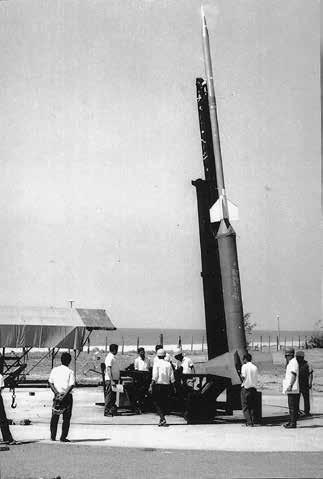
Rohini RS-D1 with a technology payload was the first satellite designed in India and launched from India by the first Indian launcher SLV3 in 1981.
This shows that Indian satellite design and fabrication capacities were ahead of the launcher development though the developments went in parallel but with a lag of nearly six years. For EO satellites a fully Indian effort from design to launch happened only in 1982 with the launch of Rohini RS-D2 by SLV3-D2 from SHAR. Table 2 gives a compressed view of the Indian satellites launched up to August 2023
431 foreign satellites from 34 countries have been launched using one SSLV, 32 PSLV and 2 LVM launchers over a period from May 1999 till July 2023. These satellites range from pico and nano to cubesats and larger.
The applications covered are AIS and Maritime, ELINT, GPS Occultation for Global Weather prediction, Remote Asset Management, Atmospheric studies, Broadcasting, Communications including IoT, Earth Observations - Optical and Microwave, Technology Demonstrations and Development, etc.
Another aspect is the use of the fourth stage of the PSLV as a platform for testing technologies that could become part of free flying satellites. The first PSLV Orbital Platform Experiment Module, POEM, carried six such modules from ISRO and private developers. Further launches included more such modules from Indian Laboratories and Industries.
A Pause to Review
As can be seen from the narrative the approach towards Space in India was cautious and more grounded in scientific applications. Satellites and their launchers were part of a long term view.
The use of space technology for military purposes is not overtly apparent though there are actions which indicate that this was not far from the minds of the Indian scientists and engineers.

The required supportive manufacturing environment was either in-house or with a few suppliers.
On the other hand the Chinese
realized that it was military strength that was more important and that satellites could wait till the missile program was well under way. The establishment of CAS, the Fifth Academy and the Seventh Ministry of Machine Building which took up the missile building program shows a remarkable focus and phasing. Apart from an initial help from the USSR the technology, infrastructure and training were all Chinese.
The speed with which decisions were taken and projects executed are remarkable. A Chinese satellite, launched from China, and on a Chinese launcher in 1970 left India a decade behind.
Despite this, India did not do too badly. India was ahead of China with IRS-1C and 1D and INSAT 2 but lost the way as the follow up with industry did not happen fast enough. Things are changing but clearly the two countries are on divergent routes.
Managing Editor
July-August 2023 | www.geospatialworld.net | 39
arup@geospatialworld.net Prof. Arup Dasgupta
1963: First rocket launch from Thumba
Who Owns Space?
Since the ease of access and breakdown of entry barriers, there has been substantial transformation in space business. However, which direction would it take next?
By Nibedita Mohanta
The top five players in the field of space exploration are US, China, Europe, India and Russia. Reports suggest that a lot of countries are attempting to develop their sovereign space infrastructure, while there are new entrants as well such as Australia, UAE, Poland, Africa and Luxembourg.
This reflects that the space sector is getting a lot of attraction
from investors, making a playfield for private players. Governments are also increasing their budgetary allocation for space.
As countries understand the value of satellite technology and the data procured from them, the investments will keep gaining momentum.

According to Brookings, currently 20 countries across four
continents have civil space budgets of more than $100 million, while 70 countries have active space programs including more recent additions like the Philippines in 2019 and Rwanda and Costa Rica in 2021.
Euroconsult's recently released report titled 'Prospects for Space Exploration', the global governmental investments in space exploration will reach $31 billion within the next decade.
40 | www.geospatialworld.net | July-August 2023 MARKET TRENDS
The key budget drivers in space are said to be continuation of increased funding in transportation, orbital infrastructure, and lunar exploration.
‘Major programs by the top most countries, along with the active participation of new countries, are the main drivers of growth, while the moon and cislunar space remain the next global strategic priority’, as per the report.
Tectonic Shift
According to Brookings, Countries and companies of all sizes are taking advantage of these trends already. Small satellites make up about 94 percent of all spacecraft launches, growing from a total of 53 to 1,743 from 2017 to 2021.
New companies are leveraging small satellites to build large broadband constellations including SpaceX, OneWeb, Telesat Canada, Samsung, and Boeing, among others.
“Private players are playing a key role in the space dynamic. In the U.S., private players like SpaceX offer the United States the strategic advantage of reusable rockets that can launch to Low Earth Orbit”, says Namrata Goswami, space policy & international relations expert and Professor, Arizona State University.

She points out that both SpaceX and Blue Origin are building rocket systems, with the former having largest satellite constellation in the world, Starlink.
“In the 21st-century, commercialization is the primary fuel, and therefore every nation is currently trying to get better with their available resources, for example, unlike the space race, today countries are trying to use space technology to add value to their economy and enhance other industrial verticals”, believes
Omkar Nikam, Space & Defense expert.


Nikam is of the view that space is also becoming more of a strategic tool to navigate the global security sphere and to complement and enhance the strategic aspects for the nations to achieve an edge in geopolitics.
The post-colonial developing world has benefitted greatly from the economic shift that has taken place in the post-cold-war era, in large part on the back of innovations in connectivity and communications.
“At the end of the Cold War in 1990, 82% of the global GDP in dollar terms was being produced by OECD countries, in 2000 it became 80%, and in 2020 it became 60%. Today it is 44% for the first time in human history”, remarks Syed Akbaruddin, India’s Former Permanent Envoy to the
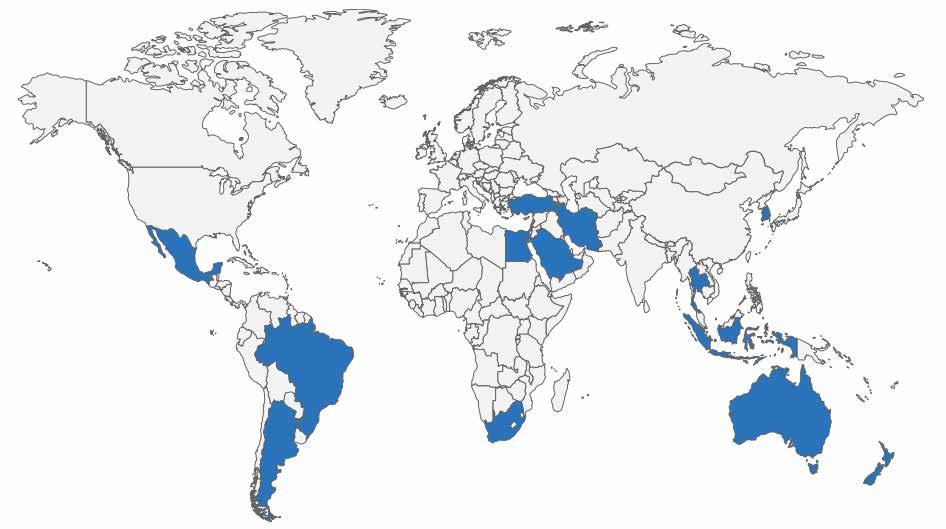
Selected emerging spacefaring nations July-August 2023 | www.geospatialworld.net | 41
United Nations.
Companies belonging to the former Global South, India and China, are leaving their footprint in space.
In China, commercial firms such as ispace and Linkspace are building reusable rocket technology. While India privatized space manufacturing this year, with an aim to increase its share of the global space market to more than five-fold by 2030.
"Galactic Energy is investing in satellite internet constellations to include broadband capability that can support China’s hypersonic vehicles” adds Goswami.

Widening Participation
With technological innovations in place, there is a growing trend of miniaturization of equipment like
satellites, sensors, cameras, and the decreasing launch costs, has encouraged many countries to develop their sovereign space infrastructure and be a part of this Space Race.
“In the future, AI advancements, other data sources and satellite innovations have the potential to enhance spaced-based data for companies as these technological areas help increase access to a diverse array of spacebased data and services at more affordable prices,” states Dylan Taylor, Chairman & CEO, Voyager Space Holdings to Forbes.
“Role of private both US and China as well as elsewhere is likely to influence thinking and strategy. Their power in the strategies of nations is likely to increase”, says S Chandrashekhar, JRD

Nikam adds, “Private players are still heavily dependent on the government contracts in the upstream market. One key aspect that needs to change is the way Private players operate with the government narrative”
He emphasizes on the need for commercial space players to develop their independent narrative strategy and accordingly scout for new market opportunities.
Towards a New Monopoly?

From the Sputnik in 1957 till today, there are around 9,000 satellites in orbit.
Ambassador Akbaruddin states that “Just one company plans to launch 12,000 satellites, and It is also seeking approval of 30,000
Tata Visiting Professor, National Institute of Advanced Studies.
42 | www.geospatialworld.net | July-August 2023 MARKET TRENDS
Creation of space agencies since 2000 (ESPI database)
more low earth orbit satellites.”
Calling Elon Musk as akin to a new sovereign of low-earth orbit, he paints a grim reality. “Critics are saying that Elon Musk sovereignty will soon be in place in the lower earth orbit.
“Elon Musk singlehandedly owns more satellites than China, Europe, Russia, Japan, India put together. He has the most powerful rocket and an operational launch and space capability that is pushing US space power in a significant way”, adds S Chandrashekhar.
With the massive financial wherewhethal, technological edge, and resources at disposal, this means that Musk is well-positioned to set the rules, standards, the procedures for markets and to an extent even dominate the innovation cycles for future space technology.
Moreover, Amazon's OneWeb has approval from the US for a constellation of 3,600 satellites and it has approval from the FCC, (the US Federal Communications Commission) for another 6,000 satellites.
“China has plans to launch two constellations totaling 13,000 satellites. They are trying to promote 6G using those satellites. These are all space faring nations and big companies. But look at what's happening elsewhere. Rwanda, which set up its space endeavor just recently has applied to the International Telecommunications Union for approval of 300,000 satellite launches.”
Market Concerns
The number of working satellites are increasing every year by the
margin of approx. 30-50% because new non-state commercial actors are exploiting large costs to build businesses in space. The rush to tap commercial space has fueled concerns because there is no space traffic management system for low earth orbit satellites, and this is where most commercial satellites are now targeted.
Nikam adds, “It all boils down to national interests and the common interests of a group of nations. Encouraging multilateralism through government institutions is not enough, hence the involvement of commercial players, think tanks and other organizations should be increased in the diplomacy sphere.

These engagements will bring a much wider perspective on topics such as 'Sustainability' in the space industry, as well as also help create a strong foundation for the peaceful use of space resources.”
International Space Laws
Orbital debris has been a problem since Sputnik1. There are at least half a million pieces of debris circulating and even tiny fragments can destroy space assets on impact.
The Kessler syndrome, according to the European Space Agency, even if all launches were stopped today, the amount of space debris in low earth orbit would still likely to increase.
Ambassador Akbaruddin stated, “The private sector will not bear the large upfront costs of placing valuable hardware in an orbit or tie
up with those who put up satellites if celestial trash makes satellite operations too risky.
The 1967 outer space treaty prevents governments from extending their jurisdiction into space, but they retain the authority over objects put into space including the rights to destroy them so they have extraterritorial sovereignty over their own objects. Is this adequate?”
He mentioned that there is no international coordination mechanism from where you deploy your constellation, regulations exist about interfering with broadcast frequencies or other satellites, but no international system of space traffic control. There is no independent global body providing data on satellite positioning and trajectories.
“That job is currently done by the US military, but some information is still classified. There are no binding regulations to help others avoid spacecraft or who should move out of the way first. And there are no common enforcement principles.”
Nibedita
"There has to be consensus on what distance constitutes a ‘safe close approach’ of one satellite to another. Nations need to agree to a set of rules like debris removal, space traffic management and a commitment not to test an Anti-satellite Weapon in space that creates debris”, says Goswami. Assistant Editor, Geospatial World Nibedita@geospatialworld.net Mohanta July-August 2023 | www.geospatialworld.net | 43
Brave New World of Space
With increasing relevance of space for commercial interests as well as power projection, a new dimension gets added to the complex matrix of geopolitics.
 By Aditya Chaturvedi
By Aditya Chaturvedi
Who controls low Earth Orbit, controls near Earth space. Who controls near-Earth space dominates Terra. Who dominates Terra, determines the destiny of humankind.
~ Everett Dolman, Author of Astropolitik: Classic Geopolitik in the Space Age, and Professor, Strategy, US Air Force War College.
The perennial quest to understand the mysteries of the cosmos, is among the oldest human endeavors dating back to the dawn of civilization. The first rustlings of ‘Space Race’ were perceptible when ‘amateur radio enthusiasts in the USA heard a series of blip sounds on short wave radios’. This
was the transmission sound from Sputnik 1, world’s first satellite, launched by the USSR in 1957. Tim Marshall vividly describes it in his book ‘The Future of Geography’
As is commonly said, the significance of momentous events is often not fully grasped in their inchoate stages. Nonchalant about
their success – and what it means – the launch of Sputnik was just a footnote in the Soviet daily Pravda, while it was front-page headline in the US newspapers.
US President Eisenhower initially rebuffed the Sputnik as ‘small ball in the air’, but it didn’t take long to realize the gravity of it. Two months after the Sputnik launch, when the American Vanguard Test Vehicle Three crashed and exploded, it was a moment of gloom, introspection, and reckoning. The rest, as they say, is history.
Some of the memorable episodes from the early days of the space race, make it seem less like a sideshow to the Cold War, but a confrontation in its own right, impelled by classical motives of power politics, one upmanship, and aiming to demonstrate the superiority of their respective socio-political systems in that bygone era of bloc alignments and US Capitalism vs Soviet Communism.
Eisenhower’s somber speech on the USSR surpassing the free world in space technology gave the impetus for the formation of DARPA
44 | www.geospatialworld.net | July-August 2023 SPACE RACE
Five Space Pioneers
Konstantin Tsiolkovsky was a visionary Russian scientist and pioneer in astronautics. Born in 1857, Tsiolkovsky is often referred as the "father of astronautics" for his groundbreaking work in rocketry and space travel theory. His most notable achievement was formulating the rocket equation, which laid the mathematical foundation for space travel and rocket propulsion.

Robert H. Goddard was an American physicist and engineer who is considered one of the founding figures of modern rocketry. Born in 1882, Goddard conducted pioneering experiments in the early 20th century that demonstrated the feasibility of using rockets for space travel. His work included developing and patenting various rocket propulsion technologies, such as the first liquid-fueled rocket.

Sergei Korolev was a Soviet engineer and space designer, often referred to as the "Chief Designer." Born in 1907, he was instrumental in leading the Soviet space program during the Cold War era. Korolev's leadership and vision led to the launch of Sputnik 1, the world's first artificial satellite, in 1957, marking the beginning of the space age. He was a key figure in the development of the Vostok program, which successfully sent Yuri Gagarin into space as the first human in 1961.

Wernher von Braun was a German-American aerospace engineer and space architect. Born in Germany in 1912, he is best known for his role in developing the V-2 rocket during World War II and for his subsequent work on the Saturn V rocket that propelled the Apollo missions to the Moon.

and NASA – two stellar American science & technology institutions – that have spawned innovation, unlocked value, and sparked dynamism across multiple sectors.

Perhaps un-ironically, when David Graeber, the noted anthropologist, called the US space program the greatest accomplishment of Soviet Communism, it was an allusion to the dialectical and inductive effect of technology rivalry.
Unlike the proxy wars waged in distant corners of the globe, this facet of the Cold War not only had a net positive enduring legacy, but created an entire ecosystem worth billions of dollars. It is today at the kernel of most technology innovations, as well as, everyday applications, serving as a bedrock of connectivity, access, monitoring, and visualization.
It has also emerged as the next terrain of extending national influence, scientific prowess, and prestige.
Era of Astropolitics?
Elon Musk is an entrepreneur and visionary known for his work in various industries, including space travel. Born in 1971, Musk co-founded SpaceX in 2002 with the goal of reducing the cost of space travel and making humanity a multi-planetary species. Under his leadership, SpaceX achieved several significant milestones, such as developing the Falcon 9 rocket and the Dragon spacecraft, which revolutionized the commercial space industry.

National Security and Defense have been key motivations for space since the heydays of the Cold War. What unnerved the US about the launch of Sputnik 1 was the fact that it was launched aboard R-7 Semyorka, the world’s first Intercontinental Ballistic Missile (ICBM).
With this, Kremlin demonstrated not just its capability to reach space, but also the ability to hit targets on US soil. This was, naturally, a cause for worry.
The dilemma between the use of space for peaceful purposes to reap socio-economic develop-
Konstantin Tsiolkovsky
Robert H. Goddard
Sergei Korolev
Wernher von Braun
July-August 2023 | www.geospatialworld.net | 45
Elon Musk
ments, and advancing national developments, or to bolster defense capabilities and national frontiers, is an old one. Though increasingly, in today’s age of networked and hybrid warfare, the two need to complement each other and are not seen as mutually exclusive.
As Professor Arup Dasgupta, former Deputy Director ISRO and Managing Editor, Geospatial World, mentions the initial trajectory of the space programs of China and India was similar, but later Beijing geared it more towards missile programs.

However, since the advent of GNSS, near real time information sharing, precise location-intelligence, accurate visualizations, profusion of geospatial data, and
the increasing salience of GeoInt since the ongoing Ukraine conflict, space has become inherent to defense and national security considerations, not just limited to the two former superpowers.
With leading countries such as the USA, UK, France, Japan raising space commands/ space forces, and India recently launching Defense Space Agency, though not going the fully to launch designated Space Force, it is clear that focusing on space defense capability will be a major national priority.
Inflection Point
Ever since the age of exploration and the scramble for territories, resources, and new markets in the 17th and 18th centuries, geography has been at the core of global politics. Its centrality is best summed
Navigating geographic constraints, finding a way around deadlocks, and exercising choices according to latitudes, longitudes, and natural barriers, is a fundamental prerequisite in geography. It isn’t an overstatement to say that ‘geography is destiny’ in international relations.
While ‘geopolitics’ is again in vogue today, perhaps for the first time since the dissolution of the Soviet Union in 1991. What was perceived as the ‘End of History’ –or the terminal end of nation bloc politics, alliances, and gambits to extend global hegemony, has made a comeback – though with the rise
up by the titles of two books –Revenge of Geography by Robert Kaplan, and Prisoners of Geography by Tim Marshall.
46 | www.geospatialworld.net | July-August 2023
RACE
Space Debris
SPACE
of multipolarity, and transactional alliances over iron-clad ideological rigidity or political fealty.
"Russia is still big. Europe (France, Germany, Italy, The Netherlands) also UK, Japan, India, North Korea and Iran have also become space powers or emerging space powers. This is what we call an oligopoly in economics or multipolar in the geopolitical world”, says S Chandrashekhar, JRD Tata Visiting Professor, National Institute of Advanced Studies.
Ancient Greeks described powers as either land-based (military), termed as Tellucracy, or sea-based (naval), called Thassalocracy.
Taking a leaf from these, the foremost geopolitical thinkers of our era – Halford Mackinder (Heartland), Nicholas Spykman (Rimland), Admiral Alfred Mahan (Primacy of Sea) – who not only shaped the discipline, but whose influence animates strategic thinking and policy-making even today, outlined the behavior, choices, compulsions, and restraints of land powers and sea powers.
Space is the new determinant in this matrix, for civilian as well as military purposes. That’s why the boundaries of conventional geopolitics are being pushed towards astropolitics.
Space rivalry won’t be just for securing orbital space for satellites in the ever-congested low-earth orbit for Earth Observation, remote monitoring, and reconnaissance, or to deploy spy satellites, but a bid for inter-planetary exploration to look for rare earth minerals, water, ice, helium etc, or to conduct scientific experiments taking the advantage of micro-gravity.
“It’s believed that the moon contains reserves of silicon, titanium, rare earth metals and aluminum. Humanity is destined to spend more time there, digging beneath the surface in pursuit of these metals, which are used in vital modern technologies”, writes Tim Marshall.
“Many countries have the incentive to go after them, especially those that don’t want to rely on China, which holds a third of the world’s known reserves”, he adds.
Mike Bechtel, Chief Futurist, Deloitte, says that space today is an ‘inflexion point akin to the Age of Exploration’.
New Space Race – A continuum or rupture?
The original space race between the USA and USSR, saw a series of Soviet firsts in space – satellite, dog, man, woman, moon rover – and the US catching up
and outstripping with ‘Giant Leap for Mankind’ in the phenomenal Apollo 11 moon landing in 1969 that cost over $30 billion and close to a decade to culminate.
Clocking US President John F. Kennedy’s deadline for the moon race, with time pending, the successful landing on moon, changed the tack in the stiff rivalry, paving the way for competitive collaboration, best exemplified by the Apollo-Soyuz joint missions, mutual disarmaments, and later on the ISS (International Space Station) – often held as the shining beacon of space cooperation even between countries with antagonistic policies or diverging interests.
The major difference between the ‘Space Race’ and the ‘New Space’ era is the unparalleled liberalization and unshackled access. What was hitherto a monopoly of national space agencies, with core technology limited to only a handful of nations’ has achieved the semblance of a level playing field where entry-barriers as well as cost of launches is drastically being reduced.
From just one satellite in outer space in 1957, to 50 put in orbit just by the USA in 1962, today there are over 10,000 satellite hovering above the Earth, and most of them by private companies.
July-August 2023 | www.geospatialworld.net | 47
The major difference between the ‘Space Race’ and the ‘New Space’ era is the unparalleled liberalization and unshackled access. What was hitherto a monopoly of national space agencies, with core technology limited to only a handful of nations’ has achieved the semblance of a level playing field where entry-barriers as well as cost of launches is drastically being reduced.
“We have entered into a new era of space exploration. There has been an incredible acceleration in the number of satellites in space. In the past decade, there has been tremendous increase in the number of satellites in orbit”, says Clayton Mowry, President, International Astronautical Federation (IAF).
“Today, the highest number of satellites in space are by Space X and OneWeb respectively, which are both private companies. New Space actors are looking at ways to utilize capability, creating billion dollar economy”, he adds.
This seamless transition from space being a restricted-access turf of national space agencies to a level-playing field of entrepreneurship and innovation, is certainly one of the defining shifts in the past decades.
Be it mapping and navigation that powers the multi-billion dollar location economy, or the utility of satellite imagery and analytics for agriculture, infra monitoring, planning & designing, mining & metallurgy, space has been a game-changer, adding immense economic value.
“The contours of our current space age include more diverse actors, both in terms of countries and private sector actors. All of them are aided by a lower cost of space access. As more and more countries have their own space agencies, space is no longer just about large countries and their interests”, says Alexander MacDonald, Chief Economist, NASA.
In 2014, he authored a NASA report that said USA stands at the cusp of Second Space Age.
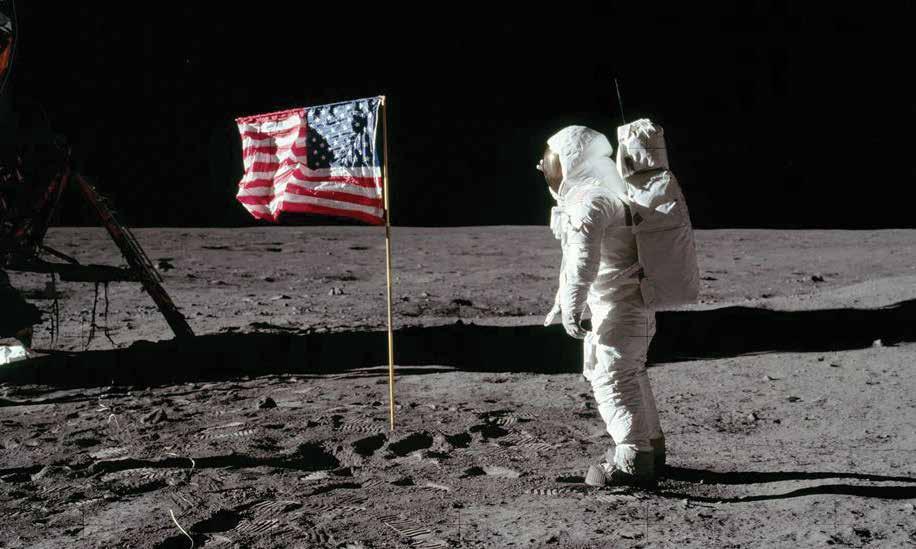
“With increasing private sector involvement, commercial interests and the intrinsic motivations of individuals are increasingly become drivers of the industry. This creates both new challenges and new opportunities”, adds MacDonald.
As per a report by Brookings, currently 20 countries across four continents have civil space budgets of more than $100 million, while 70 countries have active space programs”.
“New companies are leveraging small satellites to build large broadband constellations including SpaceX, OneWeb, Telesat Canada, Samsung, and Boeing, among others”, says the same report.
However, commercial interests and for-profit pursuits haven’t reduced the impact of geopolitical tussles in space, instead
48 | www.geospatialworld.net | July-August 2023
RACE
Apollo 11 moon mission by USA, 1969
SPACE
made them more prominent over the years, as China emerges as a spacing power with a comprehensive space program, and a series of its own firsts – first reusable launch vehicle, first SAR rocket.
Apart from the ISS, which is set to be decommissioned in 2030, China is the only country in the world that has its own space station, Tiagong One.
Though efforts are underway to build space stations, including by private companies such as Axios Space, Boeing, Lockheed Martin, and Northrup Grumman before 2027.
Russia, which launched the world’s first space station, Salyut-1 in 1971, and operated Mir space station till 2001, also plans to launch its own new space station.
Roscosmos, the country’s space agency, has invited BRICS countries to be a part of their space station program. As a consequence of the sanctions post the Ukraine invasion, space cooperation between Moscow and Beijing is deepening. Russia also plans to develop methane-fueled rockets by 2027.
The crash of Luna-25, Russia’s first moon mission after 1976, whose launch was replete with ‘Back to the USSR’ symbolism, conjuring imagery of technological autarky, as if a throwback to the old
space race, with Vladimir Putin’s statement that Soviet Union developed most of the cutting-edge tech in situations similar to sanctions.
Meanwhile, Russia has become a shadow of its former self in space capability, despite maintaining an edge in powerful rockets, launchers, and an enviable space-defence ecosystem.
Russian space sector has, off late, seen cost overruns, delays, and endemic corruption. In 2018, Alexei Kudrin, Former head of Financial Audit and former Finance Minister, red-flagged financial irregularities in the space agency.
“We have big problems with Roscosmos. There is simply irrational spending, all sorts of violations of discipline. Procurement procedures are carried out incorrectly, prices are too high, a lot of funds are wasted on unfinished objects or on objects that are simply idle, funds in the accounts have not been used for months., ” he said to news agency TASS in 2018.
Russia’s flagship Vostochny spaceport project, aimed to reduce the reliance on Baikonur Cosmodrome in Kazakhstan, world’s first and largest, which is leased until 2050 for an annual rent of $100 million, is still under construction.
Creating the Ecosystem
Although with ever-increasing demand for space data, imagery, applications, and the need to secure space assets, the pie is ever-widening, and the NewSpace market, with its high specialization, is more about collaboration, niche area expertise, and diversification.
Though ‘Creative Destruction’ is yet to unravel, and pace of the sector is exuberant, unarguably the most dazzling success story of New Space is Space X, founded and led by maverick billionaire Elon Musk.
Space X rockets have largely become the standard-fare workhorses for carrying US missions. The company is a vendor for NASA as well as the DOD. Much of drastic cost-reduction in launches, which has broken down entry barriers, is attributable to technology advances, miniaturization, conducive policy frameworks, as well Space X being the trailblazer.
As per a recent report by Bryan Space Tech, in Q2 this year Space-X lifted nearly 10 times as much mass to orbit in the second quarter of this year as its closest competitor, the nation of China. While Space X carried a payload of 214,095 to outer space, CASC carried 23,069. Third came Roscosmos with 8100 KG, followed by China National Space Agency ( 8,082 kgs).
With most of NASA as well as other government department launches carried by Space X, the picture is quite interesting. Clearly, more than 80% of the payload has been carried by Space X alone, and the gap between it, and its nearest competitor is huge, which will take a long-time to bridge. This gives
July-August 2023 | www.geospatialworld.net | 49
Space is the new determinant in this matrix, for civilian as well as military purposes. That’s why the boundaries of conventional geopolitics are being pushed towards astropolitics.
USA a cutting-edge over China in terms of number of launches as well as the payload capacity.
New Outreachs
With new accords such as Artemis and voluntary self-imposed bans on ASATs, USA is articulating its new space doctrine, which includes a wide range of participants. China has its own vision of space, which it describes, peaceful and aimed at socio-economic benefits. Beijing has long-standing space and technology outreach in Africa and Latin America.
In July, NASA chief Bill Nelson, on a visit to Brazil, offered the country NISAR satellite imagery to combat Amazon deforestation. Brazil's Space Agency has a deepseated partnership with China since 1999 for agro and environmental monitoring.
China also plans to build a spaceport in Djibouti, in the strategic Horn of Africa, where
Beijing already maintains a naval base. Earlier this year, the government of Djibouti signed an MoU with China’s Hong Kong Aerospace Technology Group ( HKATG) to construct a space port.
Closer home in Asia, China Supports space programs of Myanmar and Laos, and allows them access to its space facilities for civilian purposes.
In 2021, an MoU was signed between Russia and China to build a lunar space station. As a result of US-led sanctions on Russia, space cooperation between Moscow and Beijing will deepen. If the curtain of ‘New Cold’ war gets drawn over the world, then what is seen as space competition between US and China would morph into more synergistic and interoperable collaboration between Russian and Chinese space efforts.
Sustained Multilateralism
Indian Space Program, which has
seen highs and lows of the Cold War Era, and distinguished itself by maintaining collaboration with both the countries, has come a long way since its inception. India’s first sounding rocket, Apache Nicke, an American sounding rocket, was carried atop a bicycle, and launched from a makeshift Launchpad near a Church.
When ISRO was formed in 1969, as a successor to INCOSPAR, its first major project, backed by NASA, was SITE( Satellite Instructional Television Experiment) that transmitted educational programs to the villages.
However, in 1975, India’s first satellite, Aryabhatta, was launched aboard Soviet Kosmos-3M rocket from Kaputsin Yar launchpad near Astrakhan Oblast. India’s first man in space, also went as part of a Soviet mission.
Remarkably, in the spirit of multi-lateralism, and sustained

50 | www.geospatialworld.net | July-August 2023 SPACE RACE
Soviet re-entry capsules
cooperation, India embarked on space collaborations and partnerships with all key players.
With the successful launch of Chandrayaan-3 and previously setting a world-record for putting the highest number of satellites in orbit on a single launch vehicle, India has gained accolade for its spacing prowess.
NISAR, or the NASA-ISRO joint satellite, world’s first dual-frequency SAR ( Synthetic Aperture Radar) mission, to monitor the Earth’s surface, signifies the beginning of a new era in space cooperation between the India and USA. This is also cemented by India recently joining the Artemis Accords.
“We are seeing more and more US-India space collaboration emerging between NASA and ISRO, as well as between respective industry partners of the two countries. There are multiple economic areas where we see increasing cooperation and integration – from earth observation, to human spaceflight, and even to future commercial space stations”, says MacDonald.
Apart from US and Russia, India has space collaboration agreements with over 60 countries, notably France, the third country in the world to send a satellite to space on its own indigenous rocket.
New Delhi also allows SAARC countries to use ISRO’s NavIC navigation system, and shares satellite imagery for disaster management and hazard mitigation in the South Asian neighbourhood. There are also plans to build ground stations and terminals in broader South Asian region.
Inter-governmental Space Groupings
The ESA (European Space Agency), the space Agency of the 22 member of the European Union, is quite formidable, with its own GNSS navigation system (Galileo), state-of-the-art Earth Observation Copernicus program, and spaceport in French Guiana.
ESA also has active partnerships with other space agencies such as NASA. In 1978, ESA and NASA together launched IUE (International Ultraviolet Explorer), the world’s first high-orbit telescope that operated for 18 years.
It is noteworthy that ESA, founded in 1975, is older than the Maastricht Treaty of 1992, the foundational agreement of European integration. This goes on to show that space cooperation in Europe, has preceded abiding collaboration in a lot of areas.
China, which is known for using its Beidou navigation system as a diplomatic tool, founded APSCO ( Asia Pacific Space Cooperation Organization) in 2008, with the aim to 'promote and strengthen the development of collaborative space programs among its Member States by establishing the basis for cooperation in peaceful applications of space science and technology’.
More of a broad space forum, than a space agency grouping, its member include Pakistan, Bangladesh, Iran, Mongolia, Peru, Thailand, and Turkey.
Inspired by the ESA, African Union formed its own space agency in January this year to
promote space cooperation, align space policies, and streamline efforts between 55 member states. Its headquarters in Cairo, shares space with Egyptian Space Agency.
Algeria, Angola, Egypt, Kenya, Morocco, Nigeria, and South Africa, are some of the main African players in Space. Though since the formation of its space agency in 2020, Rwanda has been fostering many collaborations with the UN and other agencies to boost socio-economic development. It is also among the first African countries to join the Artemis Accords. Within three years, Rwanda Space Agency has also signed MoU with Esri for the use of geospatial services.
Led by Mexico and Argentina in 2020, 18 countries of Latin America and Caribbean came together to launch their regional space agency.
Based in Mexico City, and with four official languages, the Latin America and Caribbean Space Agency aims to expand cooperation for peaceful space exploration.
Policy Regulations & Sustainability
As per Satellite Industry Association estimates, there could be more than a 100,000 commercial satellites in orbit by 2029. With humungous increase in the number of satellites, and nations vying to put them in orbit, space situational awareness, orbital sustainability, as well putting together a comprehensive framework for a ‘rules-based order’ in space that governs the actions of state as well non-state actors is of paramount importance.
Though space is often referred as final frontier and common province, the steady efforts towards
July-August 2023
www.geospatialworld.net | 51
|
space weaponization, anti-satellite weapons, and electronic warfare measures to jam signals, threatens turning space into a contested arena of great power rivalries, and an extension of terrestrial sabre-rattling.
While there are agreements in place such as the Outer Space Treaty (1967), which unequivocally states that space is a shared resource of all of humanity, which shouldn’t be monopolized or restricted, a lot more needs to be done to make the frameworks either widely acceptable or legally-binding to the signatories.
“There has to consensus on what that rules-based order would look like. Right now, this discourse is dominated by ideas and norm building that tends to be western in origin. Therefore, the developing world expresses wariness due to their colonial past as well as concerns that norms are not
legally binding”, believes Namrata Goswami, space policy & international relations expert and Professor, Arizona State University.
The Artemis Accords is a step in the right direction, though it doesn’t include Russia and China. However, it remains non-binding, and a comprehensive mechanism still needs to be worked out to monitor and mandate space rules for all.
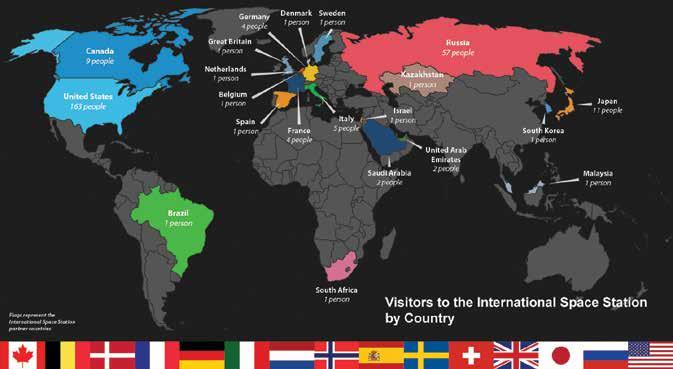
United Nations Committee on Peaceful Use of Outer Space (COPUOS) is another benchmark. It has over 100 signatories who commit to peaceful civilian use of space.
"Just a few years back, over 90 countries signed an agreement on long-term sustainability guidelines. Now these countries need to make it a part of licensing and authorization for space activities", says Moriba Jah, a renowned space environmentalist.
In the era of burgeoning private players and states liberalizing access, and divesting control, it is hard to determine where the buck stops when it comes to being responsible space actors – with the governments, multi-lateral organizations, or private behemoths. But creating an enabling environment and setting up rules of conduct, safety, and security is the domain of states.
"Governments are ultimately responsible because they bear the legal liability for damage and harmful interference in outer space, as well for authorizing companies and organizations to engage in space activities", adds Jah.
Drawing an analogy with the ITU (International Telecommunications Union) is responsible for radio frquency allocation to everyone in the world, some similar arrangement needs to be worked out for orbital capacity allocation as well.
52 | www.geospatialworld.net | July-August 2023 SPACE RACE
We need to makes rules for what Jah deems the ‘Wild West’ of space – lack of regulations and a massive spurt in the number of launches.
Another complexity in the New Space Race is precisely what lends vigor, vibrancy, and dynamism to it: multitude of space actors and ambitious new entrants.
"Multiplicity of space players also adds to the complexity because different countries have varied motives for space exploration. Some may want to focus on national security, while others or economic benefits, or enhancing national prestige, or a mix of all. This makes it a little harder to secure agreement on many things between different space players", asserts Dr.
Brian Weeden, Director, Program Planning, Secure World Foundation.
He also stresses on the need to enhance space sustainability awareness among the end-users of space data, such as space application consumers and the geo-intelligence community.

Dr. Weeden also cites the example of the working group of COPUOS and over 100+ nations who agree to it, signifying that the awareness and will on space sustainability is already there.
Time to put our act together, channelize our efforts together, align our synergies, and see the celestial as a shared heritage for posterity.
Moribah Jah rues that “there is no global coordination on how space is used, and no joint management of orbital space”, which allows countries to launch whenever they want, and from wherever till the time they incur ‘damages and harmful interference.
Spawning Innovation
Dividends of space pay-off not just in the form of direct benefits to millions of citizens via precise imagery and analytics, improved communication networks, reliable early warning systems, but also the multiplier effect on everyday consumer applications, and the boost to multiple sectors.
On the face of it, what could be a commonality between portable water purifiers and firefighter masks, except that both trace their genesis to the Apollo Space program.
And not just that.
As per Tim Marshall, be it heat-resistant clothing, laptops, wireless headsets, LEDs lights, or memory-foam mattresses, all trace their origin to ‘space race’.
Apart from turbo-charging innovation and catalysing technology permeation, space holds a lot of other lessons for new business paradigms and sustainability endeavours.
Economist Mariana Mazzucato calls the Apollo space program the epitome of mission-oriented policy and innovation that should serve as a template for policymakers to deal with complex challenges.
Time to re-look at the Apollo and extend its spirit of collaboration, targeted outcome-focused work, and solidarity beyond national frontiers.
The global space economy is expected to hit the trillion dollar mark by 2030, and space being an integral part of our lives today, from the most mundane applications to highly critical and classified defence operations.
The words of Konstantin Tsilokovsky, the father of rocketry and cosmonautics, ‘Earth is the cradle of humanity, but we cannot remain in the cradle forever’, resonate as we prepare for a new epoch of technology transition and fast-connectivity.
Aditya@geospatialworld.net Aditya Chaturvedi
In the era of burgeoning private players and states liberalizing access, and divesting control, it may be said that it is hard to determine where the buck stops when it comes to being responsible space actors – with the governments, multi-lateral organizations, or private behemoths. But creating an enabling environment and setting up rules of conduct, safety, and security is the domain of states.
Associate Editor, GW Media
July-August 2023 | www.geospatialworld.net | 53
Demystifying High-Res Imagery
By Arup Dasgupta
Authors:
Publisher: Whittles Publishing 2022
Remote Sensing satellites have revolutionized civilian Earth Observation. While the early Landsat imagery offered great synoptic views, it soon became evident that resolution had to be sacrificed for synoptics. Hence, resolution became the defining parameter and civilian satellites were launched with greater resolutions.
The flip side of this was the need to develop new image analysis techniques because the old ones like K-mean, MXL and PCA which relied on the spectral properties of the synoptic imagery, could not handle the increased spatial diversity of high-resolution imagery.
In this context the book, High Resolution Optical Satellite Imagery is a welcome addition to the literature on satellite imagery analysis. The book covers a range of topics from the history of high-resolution sensors to basics of imaging the earth from space, and variety of applications. It includes all the high resolution satellites launched up to the date of publication.

Photogrammetry has always been one of the important uses of high resolution photographs and
Reviewed by: Prof. Arup Dasgupta
imagery and this book does full justice to it.
The book begins with an exhaustive theoretical discussion on definitions, basic principles of orbits, imaging and image corrections using the earth satellite imaging geometry. It also sets the context for high resolution imaging in optical and radar bands from air and space and also includes LiDAR. Such a comparative treatment is most useful for deciding which sensor to use for which purpose.
Chapter two gives an excellent overview of the history of imaging from space, leading up to the present day developments in both aerial and space borne sensors. It also touches upon imaging sensors for planetary missions.
Chapter three delves into optical sensor design, including stereoscopic concepts, important parameters for space borne mapping, and otto-mechanical design. It ends with data recording and transmission.
The book divides high resolution sensors into two groups, two metre to 16 metre and below two metre resolutions. In both the
groups all the sensors including photographs sensors are described in detail. This is a very valuable compilation for researchers. Chapter six goes into detailed discussion on calibration, sensor models and orientation.
With high resolution imagery and in particularly in photogrammetry these parameters are crucial to the analytical products derived from the imagery. The treatment is very well done and again this is a good reference material for those working with high resolution data for topographical mapping.
Chapters seven and eight deal with data processing, data products and applications. While chapter seven includes global DTM from different sensors among other topics on data processing, chapter eight covers a variety of applications through several interesting case studies.
Chapter nine deals with future developments including policies and future markets.
Overall, this is an excellent publication which will prove useful to students, developers and researchers.
54 | www.geospatialworld.net | July-August 2023
Ian Dowman, Karsten Jacobsen, Gottfried Konecny, Rainer Sandau
BOOK REVIEW


Strategic Sponsors Bronze Sponsors Cloud Partner Supporting Partner Produced By www.geosmartindia.net Space Economy Urban Development Environment and Climate Change Mining and Exploration Utility and Networks Agriculture and Irrigation Water Resource Management Land and Property #GEOSMARTINDIA 17– 19 OCTOBER 2023, HICC, HYDERABAD, INDIA The Ultimate Tech Fusion Marvel Geospatial Innovation Meets Digital Transformation!

www.geospatialworldforum.org Join the conversation Witness the various facets of the ongoing transition of the geospatial industry and its existing and potential value in the world economy. Thought-provoking, Industry-advancing Topics and many others… Defense Generative AI National Mapping Infrastructure Geology & Mining Energy and Telecom PNT & GNSS Land & Property ESG & Climate Change Digital Twins & Metaverse Hydrography & Maritime UAVs USER FOCUS DEEP DIVE TECH SESSIONS DATA & ECONOMY 13-16 May 2024, Rotterdam POWERING THE WORLD ECONOMY Geospatial Transition












































































 By Aditya Chaturvedi
By Aditya Chaturvedi












